RAINBOW EUCALYPT MAN
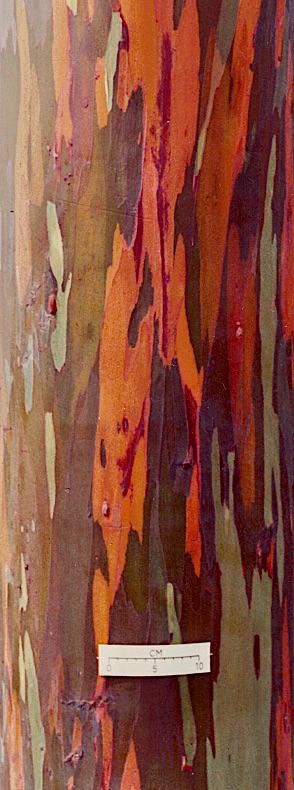


1967 2
Botanical exploration 2
Preparation of a paper for the Ninth Commonwealth Forestry Conference 29
Natural regeneration of E. deglupta 30
Artificial regeneration of E. deglupta from seed 32
Grafting E. deglupta 33
Growing cuttings of E. deglupta 37
Confirmation of E. deglupta as a major native tree species for continuing study 44
I enrol in a Master of Forestry Degree at the ANU 46
1968 47
Ninth Commonwealth Forestry Conference 47
Duty travel to Canberra and ANU for initial wood properties examination on E. deglupta 47
Density of the wood of E. deglupta 48
Structure of the wood of E. deglupta 51
Fibre length 51
Statistical design required for the proposed tree improvement programme for E. deglupta 56
Continuation of research on E. deglupta at Keravat 57
Planting trials of E. deglupta 58
Preparation of a paper for a Conference of the Institute of Foresters of Australia 59
Selection and assessment of “candidate” and “breeding” populations of E. deglupta 59
Grafting and cuttings of E. deglupta 60
First visit to Keravat by Professor Pryor of the Department of Botany ANU 62
Helicopter reconnaissance of the Gazelle Peninsula and Central New Britain 66
Flowering and fruiting studies on E. deglupta 69
Emasculation technique developed for flowers of E. deglupta 71
Vegetative propagation of E. deglupta using epicormic and coppice shoots 71
Second visit to the Territory by Professor Pryor of the Department of Botany ANU 75
Wood density variation in E. deglupta 85
Silvicultural Research Conference Bulolo 26 to 30 August 1968 87
1968 96
Writing up a report on the fibre length and density work to date 96
Ordering of a rifle for seed and scion collection 96
Experimental proposals 96
E. deglupta fertilizer trial 98
Professor Pryor visits Mindanao in the Philippines to examine E. deglupta 98
Vegetative propagation of epicormic and coppice shoots of E. deglupta 99
Lopping and tying down branches of E. deglupta to control height growth 99
Establishment of a trial grafted seed orchard for E. deglupta 100
Ordering of a machine for removing wood samples from standing trees 102
Arrival of rifle for collection of seed and vegetative material from tall trees 103
1969 105
Collection of seed and vegetative material of E. deglupta 105
Grafting and cuttings experiments 105
Move to Canberra to take up PhD studies at the ANU 105
Aims of the experimental work to be undertaken during my PhD 104
FAO Forestry and Timber Bureau E. deglupta collecting expedition to Indonesia 106
Fibre wall thickness and lumen diameter 107
Arithmetic ratios of fibre length, wall thickness and lumen diameter 108
Cross sectional area of fibres, fibre wall material and lumens 109
Arithmetic ratios of fibre cross sectional dimensions 109
Percentage of tissue types by volume 109
Number of vessels per unit area of cross section 110
Mean cross sectional area of vessels 110
Co authored paper for 2nd World Consultation on Forest Tree Breeding 110
Formal transfer to a Commonwealth Postgraduate Scholarship 111
Chemistry of the wood of E. deglupta 112
End of wood parameter measurement 113
Associations among the primary and derived variables 114
The association between wood density and other measured wood parameters 116
Baku Forest Station 117
1970 117
Wood sampling in standing trees at Keravat 117
Growing plants in controlled environments 119
Experimental methods for growing plants of E. deglupta in the phytotron 120
Provenance studies in the phytotron 122
Fieldwork in Keravat 123
1971 126
Species trial at Baku, Gogol 126
Membership of Forest Research Working Group No 1 Forest Genetics 127
Wood density among random and candidate populations of trees 127
Environmental and genetic variation in wood density 127
Heritability of wood density in E. deglupta 129
Selection differential 130
Selection of propagation population trees 131
Establishment of provenance trials of E. deglupta in Keravat, Dami and Gogol 132
Investigation of heart rot in E. deglupta 133
Volume tables for E. deglupta 135
1972 139
Site Quality computation for E. deglupta 139
Growth and Yield for E. deglupta 139
Completion of my PhD studies at ANU 141
Bridging Report for Silvicultural Research in PNG 142
E. deglupta seed orchard establishment in Bulolo 142
Hybrid eucalypts 145
Hybridization of E. deglupta and E. “decaisneana” 147
Provenance trials of E. “decaisneana” at Bulolo 148
Simulated pulpwood logging at Baku 151
Confirmation of the award of PhD for my work on E. deglupta 153
First species trial at Baku at age two years 154
1972 continued 161
Exploration of E. deglupta in the Garaina area, Morobe Province 161
Latest (1972), more detailed description of E. deglupta 164
Second provenance trial of E. deglupta at Baku 168
Reconnaissance on New Britain 170
1973 183
JANT start up in the Gogol 1973 183
Membership of Appita 187
JANT harvesting and reforestation activities 187
E. deglupta spacing trial, Baku 190
Thinning trials Keravat 1973 192
Heartwood decay in E. deglupta 192
Continuing harvesting plots at Keravat for pulpwood volume table compilation 194
Overseas duty travel to east Africa and New Zealand 195
Travel Bulolo PNG to Johannesburg, South Africa 196
IUFRO Division 5 Forest Products meeting 24 September to 12 October 1973, Cape Town and Pretoria, South Africa 198
PART 6
1973 continued 203
Rhodesia 203
Malawi 203
Zambia 207 Kenya 208
Back to Australia and on to New Zealand 210
Recreation leave in Australia from 18 November 1973 to 3 January 1974 212 1974 212
Visit by Christian Cossalter of the Centre Technique Forestier Tropical Congo 212
Visit to Bulolo by Edgard Campinhos Jr of Aracruz Florestal S A 221
Papua New Guinea Tropical Forestry Research Note series 221
Assessment of E. deglupta provenance trial No 2, Keravat, New Britain in 1974 at age 2 years 223
Second provenance trial of E. “decaisneana” at Bulolo 226
July Oct 1974: Vegetative propagation of epicormic and coppice shoots of E. deglupta 229 Bole shape of E. deglupta 234
Provenances 235
Initial spacing or initial stocking 235
Site quality 236
Tree age and average size 237
Practical implications of bole shape 238
An updated general volume table for E. deglupta 241
Further provenance trial of E. “urophylla” 241
Forest Tree Series Leaflet on E. deglupta 243
Progress report on tree introduction and improvement 244
1975 244
Provenance seed collection of E. deglupta in the Celebes and Ceram Islands May 1975 244
Provenance seed collection of E. deglupta in Irian Jaya, Indonesia, 3 17 June 1975 247
Natural distribution of E. deglupta 261
Taxonomy of E. deglupta 268
Taxonomic characters 270
Measurements on E. deglupta leaves preserved as herbarium specimens 272
Measurements on leaves from a provenance trial at Keravat 277
Single taxon at the level of species for E. deglupta 281
Reprinting of my PhD thesis 282
Permission to publish my work on E. deglupta 284
1976 285
E. deglupta progeny trial two years old, Kunjingini 285
XVI IUFRO World Congress, Oslo, Norway 287
1977 289
FAO/IUFRO Third World Consultation on Forest Tree Breeding 289
Post Consultation tour to Coffs Harbour 291
IUFRO Workshop, Brisbane 293
1978 293
Visit to Ulamona to investigate damage to a plantation of E. deglupta owned by the Catholic Mission and impacted by a recent volcanic eruption 293
Industrial Timber Corporation of Indonesia 300
Paper Industries Corporation of the Philippines 302
Jari Brazil 306
Seed production from the E. deglupta seed orchard, Bulolo 308 1979 310
Conference on Forest Land Assessment and Management for Sustainable Uses 310 1980 310
Visiting Scientist at the CSIRO Division of Forest Research, Canberra 310
IUFRO Symposium and Workshop on Genetic Improvement and Productivity of Fast Growing Tree Species, Brazil 311
Case studies on forest and watershed development in Asia and the Pacific 325
Reprint of Forest Tree Leaflets 326
1983 326
Publication of the papers given at the IUFRO Symposium on Genetic Improvement and Productivity of Fast Growing Tree Species in Brazil, August 1980 326
IUFRO meeting on frost resistant eucalypts 327 1984 328
Award of the Marcus Wallenberg Prize to the research team at Aracruz working on Vegetative propagation 328
PICOP at its peak in 1984 329
1986 329
Data book on endangered tree species 329 1993 330
PICOP revisited in 1993 330
1993 continued 333
UNDP/FAO Regional Project FORTIP 333
Publication of Eucalypt Domestication and Breeding 333 1994 334
Second edition of Eucalypt Domestication and Breeding 334
1995 335
Genetic variation in height growth and leaf colour in E. deglupta 335
1997 336
Pulping and papermaking potential of plantation-grown E. deglupta from PNG 336
2003 336
Molecular studies on Eucalyptus subgenus Minutifructus 336
2007 342
Breeding programme for E. deglupta in the Solomon Islands 342 2008 342
E. deglupta Seed Orchard Bulolo 342 2011 342
Herbarium collections of E. deglupta by K Damas 342
Open Bay Timber Company 344 2013 345
E. deglupta chloroplast genome sequenced 345
ACIAR Project “Facilitating the availability and use of improved germplasm for forestry and agroforestry in Papua New Guinea” 347 2014 348
Reference genome of E. grandis released 348 2015 349
Article on E. deglupta in “The Forester” 349 2017 350
E. deglupta in the Adelaide Botanic Garden 350 2018 350
E. deglupta in “Trees for Life in Oceania” 350 2019 353
Our book on “Eucalypt Domestication and Breeding” 353 Geological time line with reference to some eucalypts 354
Open Bay Timber Plantations 359
Keravat 2019 360
ABBREVIATIONS AND ACRONYMS 361
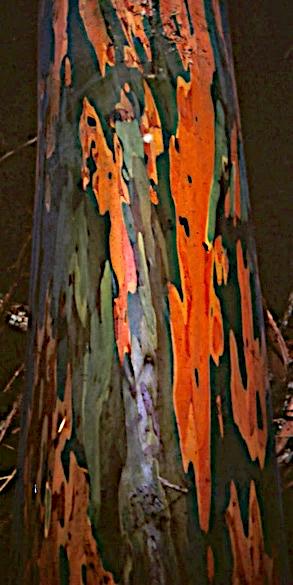
This is the story of my life’s journey with my favourite eucalypt, Eucalyptus deglupta. The specific name “deglupta” is derived from the Latin degluptere to peel, or peeling skin, referring to the way the bark peels from the trunk in coloured strips. While my interest always has been from the point of view of a forester and botanist and know it by its usual common and trade name Kamarere, gardeners and horticulturists worldwide have been attracted recently to the species because of its very colourful bark (my photograph, left) and have called it “painted gum”, “rainbow gum” and “rainbow eucalypt” and photographs of its bark, some possibly with enhanced colours, have proliferated on the internet.
I first encountered Kamarere in Bulolo Papua New Guinea (PNG) in December 1963 when I was posted there for three months as a Cadet Forester. It was growing in Bulolo as a street tree and ornamental, but I took very little notice of it then as my focus was on the silviculture of the araucarias. I cannot recall coming across it again until after I graduated and was posted to Keravat1 as a Forest Officer Class 1 and started working in forest research from 11 March 1967. Kevin White and Alan Cameron had briefed me in headquarters on my way through Port Moresby, pointing out that my principal focus would be on this species, as Kamarere was then the first placed candidate for reforestation after harvesting pulpwood in the lowland forests of PNG. Though, as sole resident research forester at Keravat on the Gazelle Peninsula, East New Britain, I also would have other tasks. The Kamarere project would be wide ranging and especially involve the exploration, collection, evaluation, conservation and utilization of the genetic resources of the species.
Keravat is a small settlement reached by road about 37 km from Rabaul by the inland route (below).
1 “Keravat” was the spelling at the time, and kept here throughout. These days the Government mostly has adopted the style “Kerevat”.
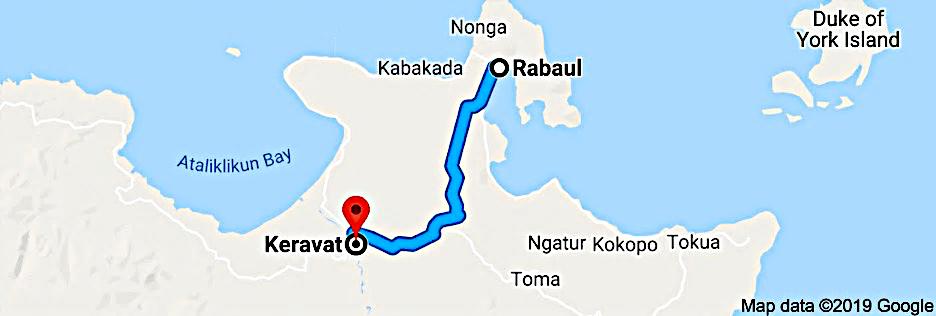
Keravat in 1967, in a hazy morning aerial view while flying into Rabaul. 1. Keravat township, 2. 1948 Kamarere plantation, 3. Fryar LA plantations of Kamarere and Teak along the west side of the Keravat River, 4. The then Lowlands Agricultural Experiment Station, 5. Derelict Keravat Aerodrome constructed in September 1943 by Japanese occupation forces but never fully operational, being neutralized by regular Allied air strikes from the beginning of 1944, and abandoned at the end of WW II, 6. Track to a popular swimming location (dark sand beach) on the nearby coast of Ataliklikun Bay, 7. Road to the northeast then around the coast to Rabaul (much longer than the inland route), 8. Keravat River, 9. Main inland road to Rabaul, 10. Keravat Correctional Institution (Kalabus, Jail), 11. The then Vudal Agricultural College.
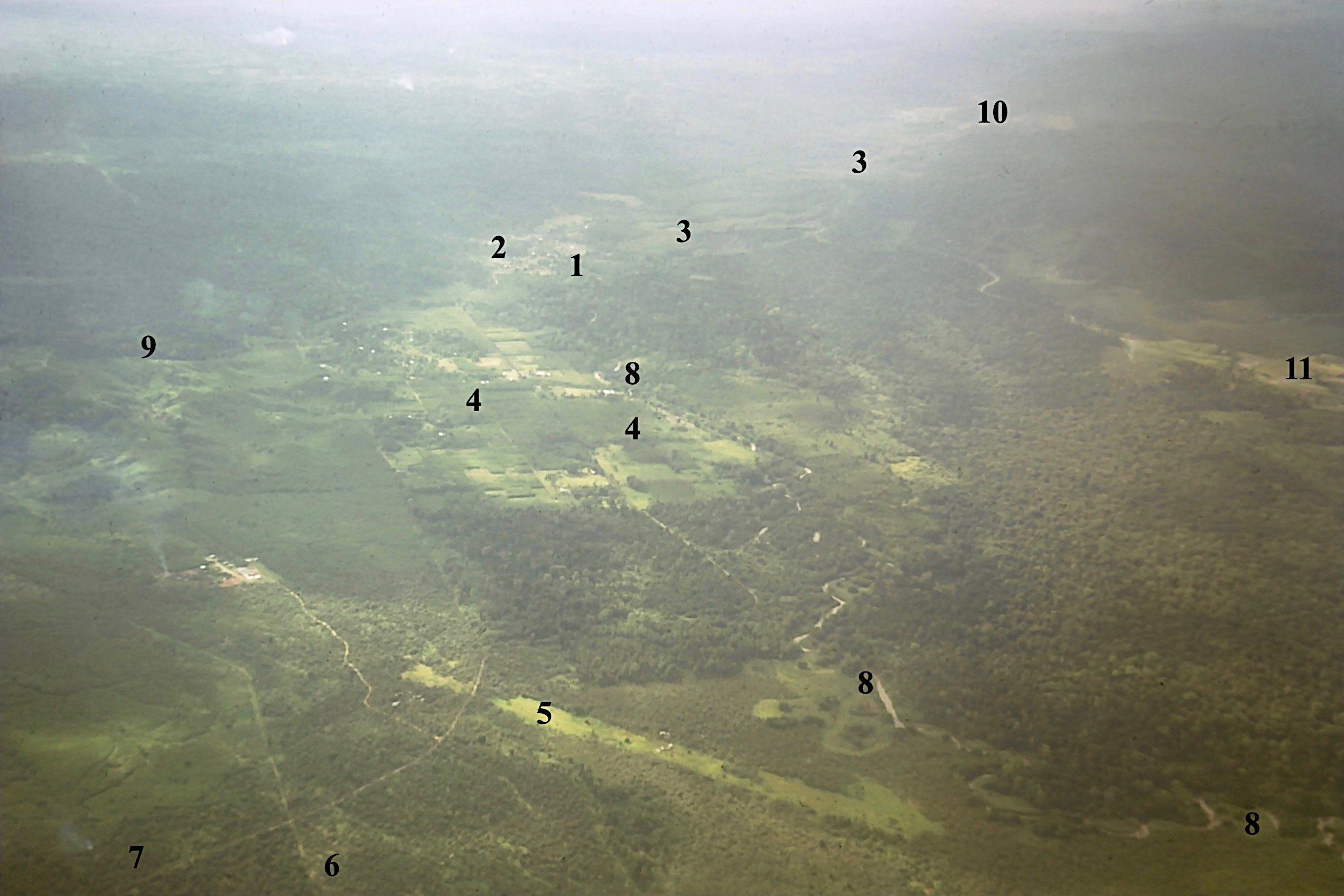
Keravat in 1967 comprised the forest station with office, nursery, stores and workshop, a residential secondary school, police station, diesel powerhouse and trade store, as well as expatriate and local staff housing for all these. Nearby there were the Keravat Correctional Institution, the Lowlands Agricultural Experiment Station (LAES) and the Vudal Agricultural College.
The then Officer in Charge (OIC) of Keravat Forest Station was Alan Fraser. The Regional Forest Officer (RFO) in Rabaul in 1967 was Elliott Tuckwell.
Left: Veteran tree near Keravat on the bank of the Keravat River in 1967. Height 68.6 m, diameter at breast height over bark (and buttresses) 8.54 m, diameter over bark above the buttresses 7.02 m. The adult person next to the base of the tree at the bottom of the photograph is holding a staff graduated in feet (1 foot = about 0.3 m). The crown shows at least two episodes of recovery after severe damage, probably caused by eruptions of the volcanoes near Rabaul.
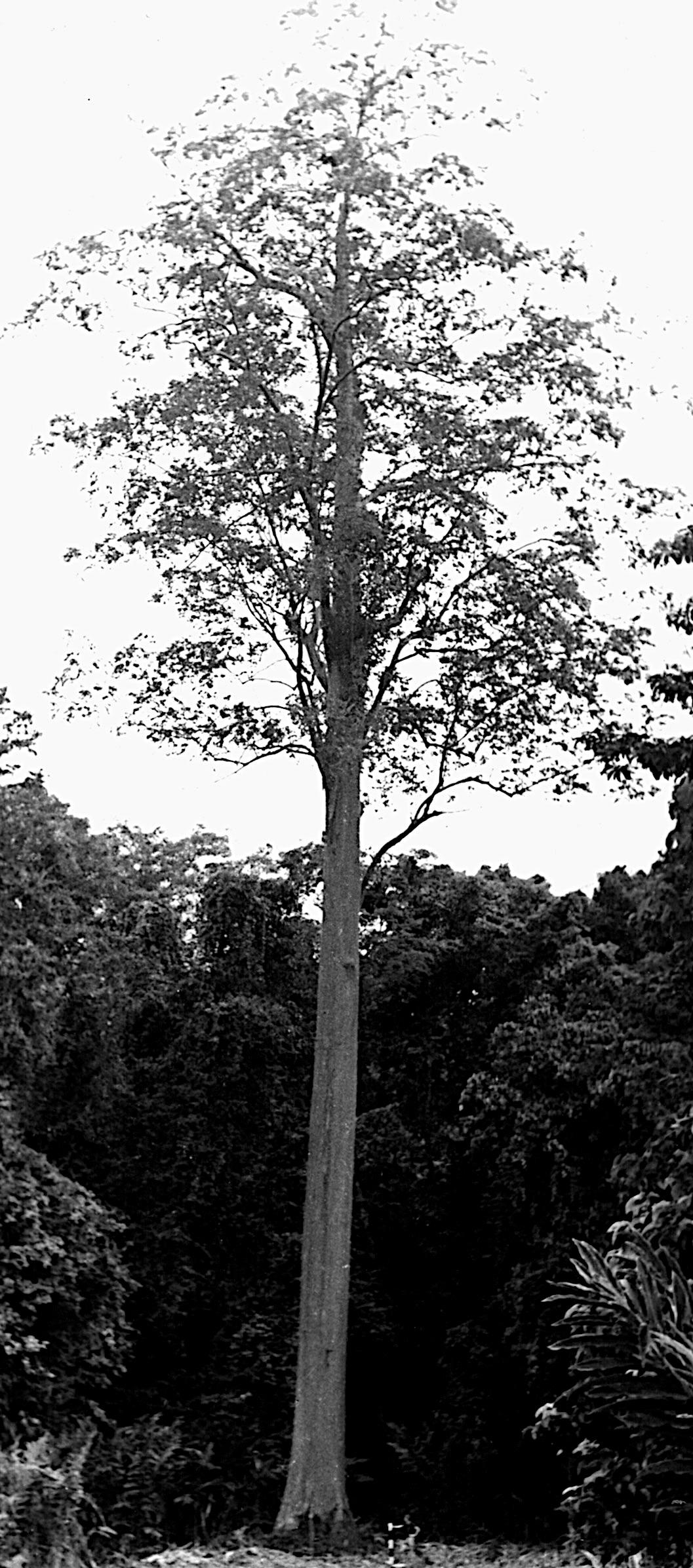
In 1967 there were about 630 ha of Teak and 311 ha of Kamarere plantations at Keravat. Natural Kamarere of several ages occurred along both the Keravat and nearby Vudal Rivers. Along the Keravat River there were occasional very large veteran trees that had not been logged during the 1950s, probably because they were hollow and contained too little sound wood to justify the effort to erect a scaffold above the large and tall buttresses and fell them with the mainly manual means of axes and cross cut saws then available.

Keravat in 1967 1968. 1. Derelict sawmill used by the Japanese during WW II, and by the Administration for a short time thereafter, 2. Small shed used for experimental grafting and mist propagation of Eucalyptus deglupta, 3. Area of nursery with beds with a concrete base set aside for mass propagation of E. deglupta cuttings, 4. Routine section of nursery equipped with wire mesh on frames to hold seedlings in plastic tubes. This was relatively small as Teak (Tectona grandis) was raised elsewhere in bush nurseries near the current planting areas, 5. Keravat Forest Office (behind the trees), 6. The Davidsons’ house, 7. 1948 E. deglupta plantation, 8. The Williams’ house, 9. Keravat Police Station houses and barracks, 10. Keravat Trade Store, 11. Road to Rabaul, 12. Road off to the left to cross the Keravat River, then straight ahead to Vudal Agricultural College or turn left to Keravat Correctional Institution (Jail, Kalabus), 13. Helicopter landing area in front of the Davidsons’ house, 14. Remnants of the old sawdust waste pile from the mill and also a storage area for soil for the nursery.

As part of the initial exploration phase, considerable effort was expended in 1967 1968 searching the World’s herbaria and libraries for specimens, photographs and literature on E. deglupta. 2 What emerged is a story about a unique and fascinating eucalypt that is worth telling in detail.
2 In 1967 1968 these individuals and organisations contributed information, photographs or loaned herbarium specimens: Prof. Dr van Steenis (former Director) and Prof. Dr C Kalkman (Director) of the Rijks Herbarium, Leiden, Netherlands; the Keeper, Arnold Arboretum and Gray Herbarium, Harvard University, Cambridge, Massachusetts, USA; Dr D M Churchill (Government Botanist and Director), Royal Botanic Gardens and National Herbarium, South Yarra, Victoria, Australia; the Keeper, Herbarium, Royal Botanic Gardens, Kew, UK; Prof. L D Pryor and the Gauba Herbarium, Department of Botany, ANU, Canberra; Mr T Hurley, the Herbarium Australiense, CSIRO, Canberra, Mr J Womersley, Director, Alick Dockrill Keeper and Colin Risdale Botanist, the National Herbarium, Lae, PNG; Dr S L Everest (Government Botanist), Dr L Pedley and Dr S T Blake, the Queensland Herbarium, Indooroopilly, Queensland; the Museum Curator for Botany, National Museum, Manila, Philippines; the Regius Keeper, Royal Botanic Gardens, Edinburgh, UK; Mr J Turnbull, Forest Research Institute, Canberra; Mrs S G M Carr, Research School of Biological Sciences and Dr W Heather, Department of Forestry, ANU, Canberra. I took the photographs of herbarium specimens, except where indicated otherwise. Mr C Roach, Department of Forests, Port Moresby assisted with processing black and white negatives and printing photographs. Ms J Shone and staff of the Library, Department of Forests, Port Moresby assisted with information sourcing and in obtaining interlibrary loans of a number of often rare or hard to source publications in an era before there were efficient photocopiers, digital photography or an internet.
E deglupta is apparently the earliest eucalypt collected and described by botanists (as ‘Arbor versicolor’) predating the first eucalypt collections in eastern Australia by more than 100 years.3 An illustration (without buds and fruits) and description appeared in Rumphius’ Herbarium Amboinense (1743) of a specimen from Ceram (now Seram, Indonesia) probably collected in 1668. Though the specimen itself was destroyed in a fire in 1687, the riverside location of the collection on Ceram, and surviving description and drawings (next page) by Rumphius4 (left), in emphasising the distinctive appearance of the bark peeling in strips and opposite arrangement of the adult foliage, leave little doubt that the specimen was E. deglupta. 5,6
C G C Reinwardt7 (left) collected the type specimen of E. deglupta near a village in the Gorontalo Regency of the Celebes (now Sulawesi, Indonesia) in 1821. It was in leaf only and he gave it the manuscript name Populus deglubata. C L Blume (right) never collected outside of Java but when he left there for Holland in 1826 he took with him the greater part of Reinwardt’s Herbarium and later issued a list8 of specimens found in it, including the following notes about specimen sheet No. 1516 Populus deglubata (translated):
“1516 Populus deglubata; Eucalyptus deglubata Bl. Celebes forests near Pagowat, September 1821.” “1516 Habitat in forests of the island of Celebes, near the rivers Pagowat, Taludujunam, etc. It is called by the inhabitants of the Celebes, Tambuli lato. A tree like balsam poplar.”
3 Early Portuguese and Dutch explorers and traders encountering the west coast of Australia, sometimes accidently after an error in navigation, likely came across eucalypts. Dirk Hartog was in the vicinity of Shark Bay (WA) in 1616, leaving an inscribed pewter plate. Abel Tasman recorded the trees in 1642 during exploration of the southwest and south coasts of Tasmania, but made no collections. In 1699, the English navigator William Dampier landed on the west coast of Australia and made plant collections which are extant and held in Cambridge, England, but there are no eucalypts among them. No formal acquisition of specimens that were eventually classified in the genus Eucalyptus was made until Banks and Solander collected in Botany Bay in 1770 on Cook’s first voyage to eastern Australia.
4 Georg Eberhard Rumphius (originally named Rumpf; 1627 1702) was a German born botanist employed by the Dutch East India Company in what is now Indonesia.



5 Davidson J 1978, Exploration, collection, evaluation, conservation and utilization of the gene resources of tropical Eucalyptus deglupta Bl. In Documents FAO Third World Consultation on Forest Tree Breeding Vol. 2, pp. 1187 1203. CSIRO, Canberra.
6 See also Miquel F A 1855 Myrtaceae. Flora Indiae Batavae 1(1):398 399.
7 Caspar Georg Carl Reinwardt (1773 1854) was a Prussian born Dutch botanist From 1816 he was head of Agriculture, Arts and Science in the Dutch East Indies, where he conducted various botanical investigations throughout the archipelago. Reinwardt was the founder (1817) and first Director of the botanical gardens at Buitenzorg (now Bogor) in Java, Indonesia There he gathered and cultivated various flora from the surrounding islands such as the Moluccas, Timor and Sulawesi
8 Blume C L 1827 28 Enumerato plantarum Javae et Insularum adjacentium ex herbariis Reinwardtii, Hasseltii et Blumei Lugduno Batavum 2vols, Leiden. Karl Ludwig von Blume (1796 1862) was a German Dutch botanist. He spent his professional life working in Java in the then the Dutch East Indies and later in the Netherlands, where he became Director of the Rijks Herbarium at Leiden. He carried out extensive studies of the flora of southern Asia, particularly in Java. From 1823 to 1826 Blume was Deputy Director of Agriculture at the botanical gardens in Buitenzorg
Above left: Rumphius’ Herbarium Amboinense Volume 3 published in 1743. Page 122 (above) has a bi lingual Latin and Dutch description of Arbor Versicolor derived from a specimen collected from Ceram in 1668. The specimen was lost to fire in 1687 but Rumphius’ drawing Tab LXXX (80) (left) and dictated Latin description survived to be published in this much delayed account. The impression of the bark decorticating in strips, the stub of an occluded branch, the opposite, dorsiventral arrangement of the adult leaves, their shape, venation including an intramarginal vein and pronounced drip tips, as well as the collection location near a river in Ceram, all point to this being Eucalyptus deglupta. That being so this documented 1668 collection of a eucalypt predates the first formal collection of the genus in eastern Australia by more than 100 years.
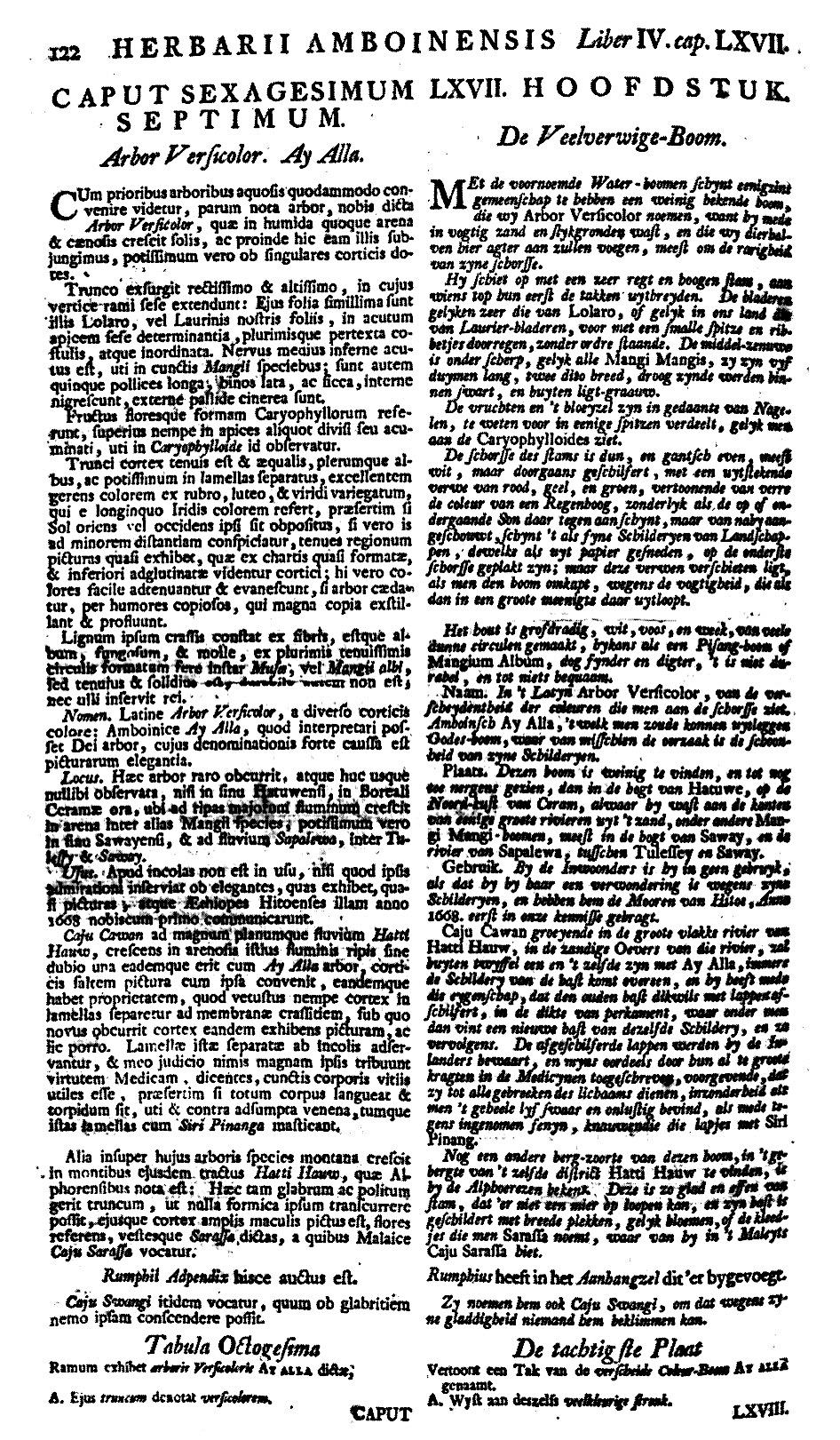
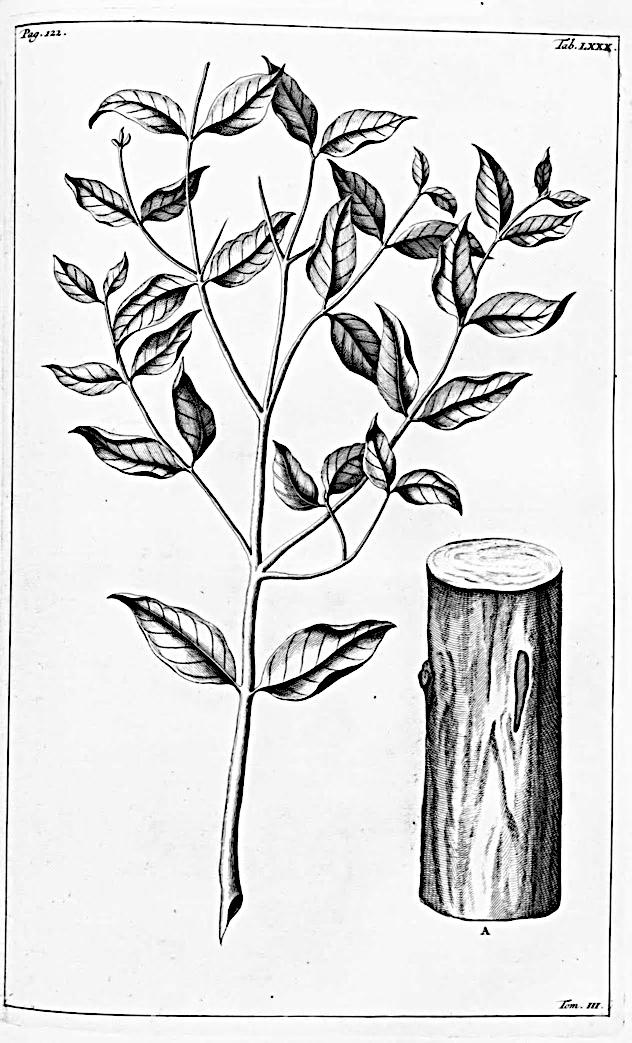

The type specimen No. 1516 of Eucalyptus deglupta, collected by C G C Reinwardt in the Celebes (now Sulawesi, Indonesia) in September 1821, held by the Rijks Herbarium (RH), Leiden, Netherlands, and photographed by them for me in 1967. (The Rijks Herbarium became part of the National Herbarium of the Netherlands in 1999.)

Blume recognised that Reinwardt’s specimen No. 1516 was not a poplar and belonged in Eucalyptus giving it the species name deglupta. 9 (See notes written on the type specimen sheet No. 1516 on the previous page.) In the same article (see next page), Blume also proposed another two new species, E. versicolor Bl., from the Moluccas, taken up from Rumphius’ description and crude figure of “Arbor Versicolor” without flowers or fruit, and E. sarassa Bl. based on Rumphius’ incidental mention of the sarassa tree, Kaju (Caju) sarassa Blume erroneously cites Rumphius’ Tab 53 instead of Tab 80 as representing E. versicolor (see page 122 and figure Tab 80 from Rumphius’ Herbarium Amboinense illustrated earlier). The figure Tab 53 in Rumphius’ Herbarium Amboinense is actually of Eugenia. 10 Blume conjecturally referred both E. versicolor and E. sarassa to Eucalyptus on account of their resinous bark, described as peeling off in flakes.11 Not a single character described by Blume for either E. versicolor or E. deglupta could definitely separate them E sarassa, however, unaccompanied by a single word of description by Blume, could not be attributed to Eucalyptus.
G Bentham12 (right) noted that the Reinwardt type specimen No. 1516 from Celebes on which Blume based his description of E. deglupta was in leaf only 13 Reinwardt’s own account of his journey to the Celebes reads as follows (translated):
“On a Friday, which was 28 September, 1821, I left Pagowat heading for areas where gold is found, namely towards Taludujunam. Among other trees which I saw was one species with a tall thick trunk devoid of what is commonly called bark, very smooth and dappled as far as the surface is concerned. I ordered one of these trunks to be cut with an axe and it seemed to me that this tree is a Poplar, closely resembling the balsam poplar, not only as regards the leaves, but also as regards the abundant growth of the branches, the yellowish colour of the petioles, the reddish colour of the branches and new leaves and particularly on account of the odour of balsam which the juvenile leaves give off when they are rubbed together.”

9 Blume C L 1850 In Museum Botanicum Lugduno Batavum sive stirpium Exoticarum, Novarum vel Minus Cognitarum ex Vivis aut Siccis Brevis Expositio et Descriptio 1(6):83 84. [In manuscript 1 June 1849, published in Part 6, April 1850] (See excerpt, next page, from a bound Volume 1 of the original separate parts that were published from 1849 through 1851.)
10 Merrill E D 1917 An interpretation of Rumphius’ Herbarium Amboinense. Philippines Department of Agriculture and Natural Resources Manila, Bureau of Science Publication No. 9:401. With almost 1300 flowering plant species mostly from the Moluccas and other parts of SE Asia, the Herbarium Amboinense by Rumphius was dictated to an assistant between 1660 and 1690 but kept secret and not published until 1741 to 1756 because of the great economic importance attached to it by the Dutch East Indies Company in its competition with rival trading companies. Rumphius was stricken with increasing blindness caused by glaucoma from 1640 and lost all of his specimens and parts of his manuscript and photographic plates in a fire in 1687. Thankfully, copies had been made of most of his manuscript and drawings and these were held elsewhere, thus they escaped the fire. Elmer Drew Merrill (1876 1956) was an American botanist and taxonomist. He spent more than twenty years in the Philippines, where he became a recognized authority on the flora of the Asia Pacific region.
11 See also Bentham G 1869 Myrtaceae. Journal of the Linnean Society of London 10:142 143.
12 George Bentham (1800 1884) was an English botanist and Secretary of the Horticultural Society of London 1829 1840. He spanned the Darwinian revolution and by 1874 had been converted from believing species to be fixed to embrace the theory of evolution by natural selection.
13 Page 143 in Bentham G 1868 Botanical Journal of the Linnean Society 10(43): 129 166.
Blume’s descriptions, “Species minus notae”, of Eucalyptus deglupta (207), Eucalyptus versicolor (208) and Eucalyptus sarassa (209) on pages 83 and 84 of Volume 1, No. 6 of Museum Botanicum Lugduno Batavum 1849 1851. “Eucalyptus decaisneana Bl: …..” (205) cited as “ In Timor”, was already a synonym for E. obliqua L’Hér. Now E. decaisneana is used as a synonym for E. urophylla S T Blake (see Blake S T 1977 Four new species of Eucalyptus Austrobaileya 1(1):1 9). The first introduction of four seedlots of E. urophylla to PNG in 1970 was under the name “E. decaisneana” (Files 105 2 84/62).

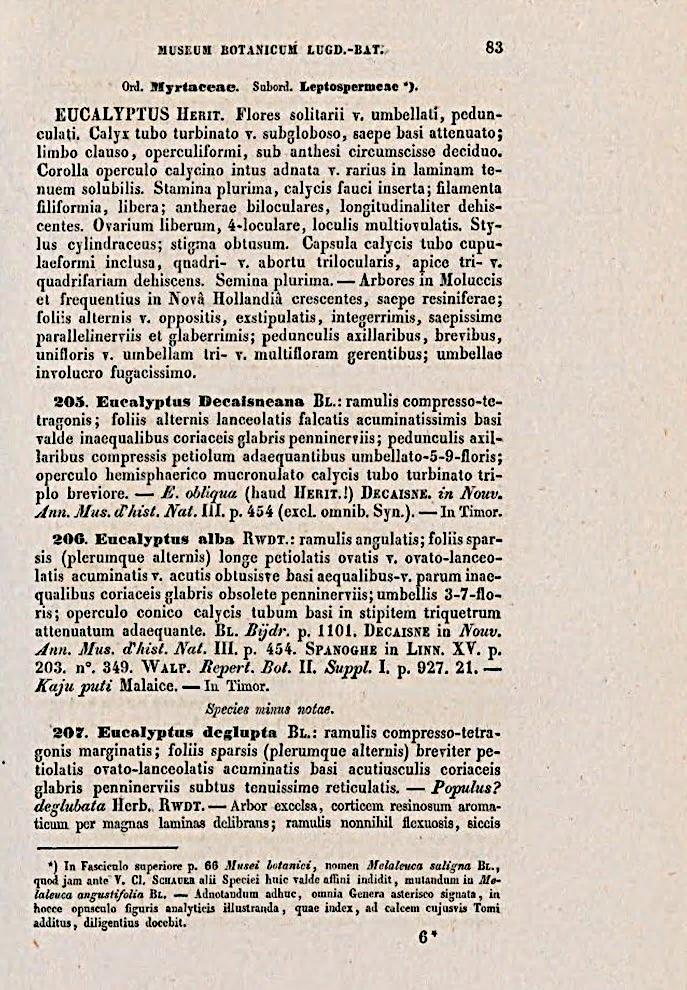

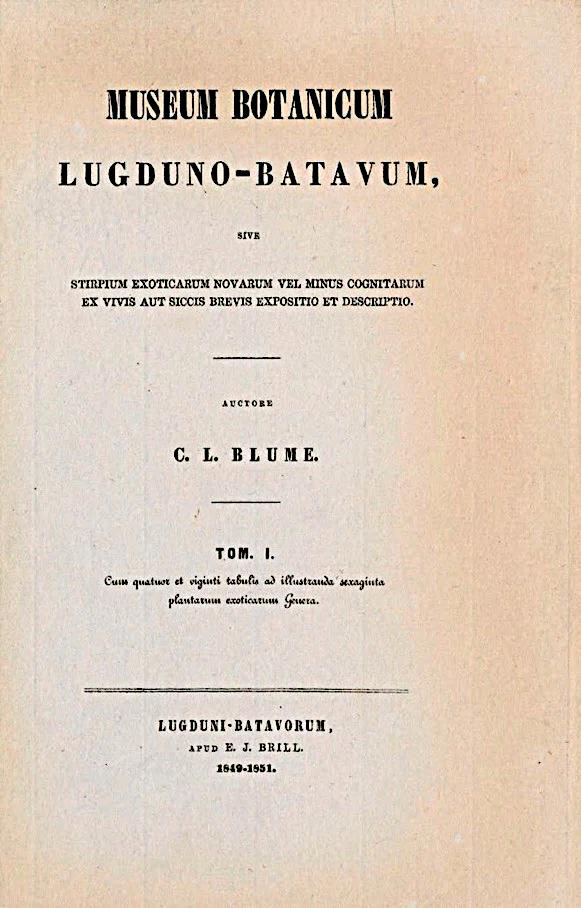
Reinwardt, in 1856, gave an additional amplified account of the supposed species,14 but he was still doubtful that it really was a eucalypt, as, for example, in the following extract (translated): “1516 Eucalyptus? deglupta Bl., Mus. I, p.82. Diospyros? Plant with ovate oblong leaves, acuminate, margins entire, very smooth. Outstanding trees, tall, it is recognized immediately from a distance by its tall, erect, striped trunk, that is, with its bark shedding in variegated patches, leaving a bare yellowish green surface. The bark itself is thin. The wood inside is white. The branches have alternate leaves. The ultimate branches are winged and four angled. The leaves are shortly petiolate, thick, leathery, with the petioles and primary nerves yellow. The odour of the leaves and branches when rubbed is strong, like the balsam of the Poplar. For this reason not only because of its habit, its quadrangular young branches, its red, resinous leaf veins, etc., but also, on account of its rapid growth, I suspect it is a Poplar. The wood is soft, useless, similar to the wood of Poplars. Carl Blume gave an excellent description of the leaves, loc. cit., p. 83.” and, elsewhere in the same article, and referring to a different specimen (translated): “103. E.? deglupta Bl. Branches compactly tetragonal, leaves ovate oblong, acuminate, margins entire, very smooth, leathery, with the petiole and primary nerves yellow, strongly smelling, pellucidly punctate.15”
The question marks in the account quoted above were Reinwardt’s! It is difficult to understand why this eminent botanist still persisted in the belief that the specimen was a Poplar, especially after he refers to having read Blume’s “excellent description of the leaves” of E. deglupta. After the placement by Blume of the species from Celebes in Eucalyptus, new issues arose as a result of poor communication among field workers and among some of the world’s preeminent herbaria. Botanists collecting from isolated regions subsequently gave different names to this same eucalypt when it was collected in Mindanao Philippines, mainland Papua New Guinea and the island of New Britain.
A specimen, this time bearing fruit, was collected, presumably by Rich in 1842 at Caldera, near Zamboanga, Mindanao, Philippines during an expedition (1838 42) led by Charles Wilkes USN. In 1854 A Gray (left, in 1870)16 described this material as Eucalyptus multiflora Rich.17 F von Mueller received in Melbourne18 plant specimens collected by “J Turner” (actually G Turner, who was reported with the Reverend Mr Brown at the time) near “Spacious Bay” (today named Wide Bay), New Britain in 1879. Von Mueller used them to describe Eucalyptus naudiniana in 1886.19
14 Reinwardt in de Vriese W H 1856 Plantae Indiae Batavae Orientalis 1:65. See also Maiden J H 1903 Critical Revision of the Genus Eucalyptus, 1(1):13.
15 “pellucidly punctate”, means having clear or transparent dots or holes, probably referring here to oil glands visible in leaves when they are held up to the light.
16 Asa Gray (1810 1888) is considered the most important American botanist of the 19th century. As a Professor of Botany at Harvard University for several decades, he regularly visited and interacted with leading natural scientists of the era, including Charles Darwin.
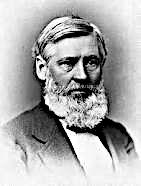
17 In Gray A 1854 United States Exploring Expedition during the years 1838 42 under the command of Charles Wilkes, U.S.N. Phanerogamia 15:554 555
18 The National Herbarium of Victoria is one of Australia's earliest herbaria, and the oldest scientific institution in Victoria. Baron Sir Ferdinand Jacob Heinrich von Mueller (1825 1896), who served as the Government Botanist for Victoria from 1853 to 1896, established it in 1853. It is situated within the Royal Botanic Gardens, Melbourne of which von Mueller was also Director from 1857 to 1873
19 Von Mueller, F 1886 Description of a hitherto unrecorded species of Eucalyptus from New Britain. Australian Journal of Pharmacy 1(7):239 240. (Reprinted in July 1886 In Botanische zentralblatt 28:179).
One of the sheets labeled “Eucalyptus multiflora Rich” in the collection of the Gray Herbarium at Harvard University. This material, collected in 1842, presumably by Rich who was botanist on the US ship “Relief” during the expedition led by Charles Wilkes USN, was in poor condition 125 years later when this photograph was taken by the Herbarium for me in 1967.
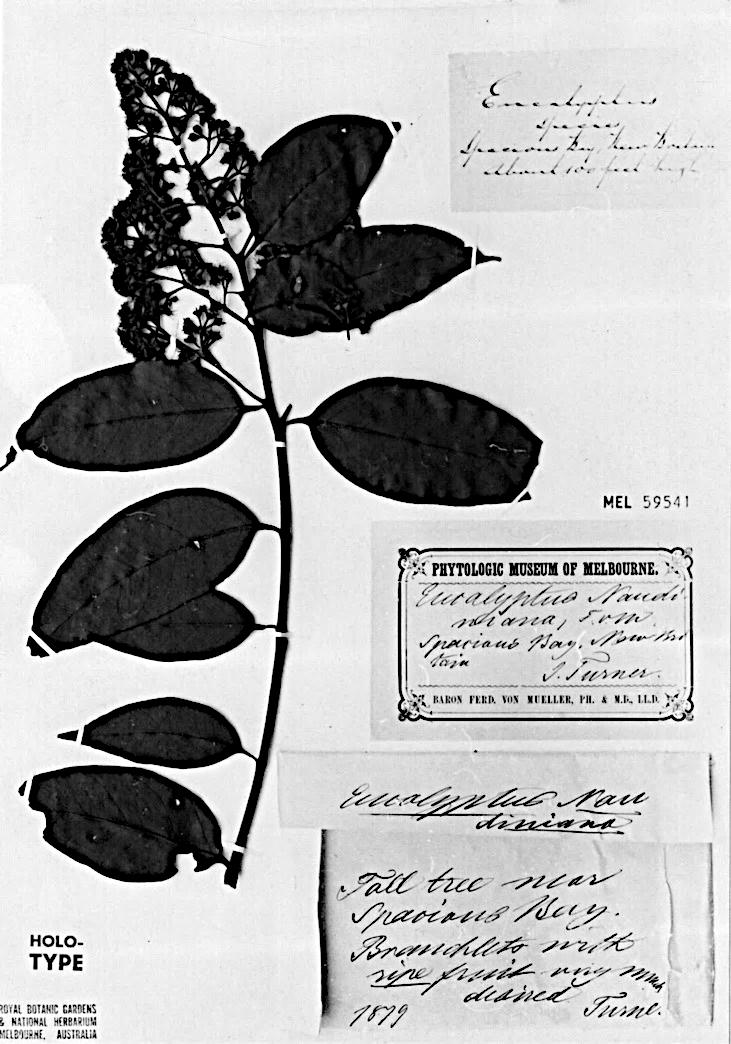
Holotype of Eucalyptus naudiniana F Muell. Specimen MEL 59541 collected by Turner in “Spacious Bay” (now Wide Bay) in New Britain in 1879 and held by the Royal Botanic Gardens & National Herbarium, Melbourne, Australia. (Photograph provided to me by the Herbarium in 1967.)
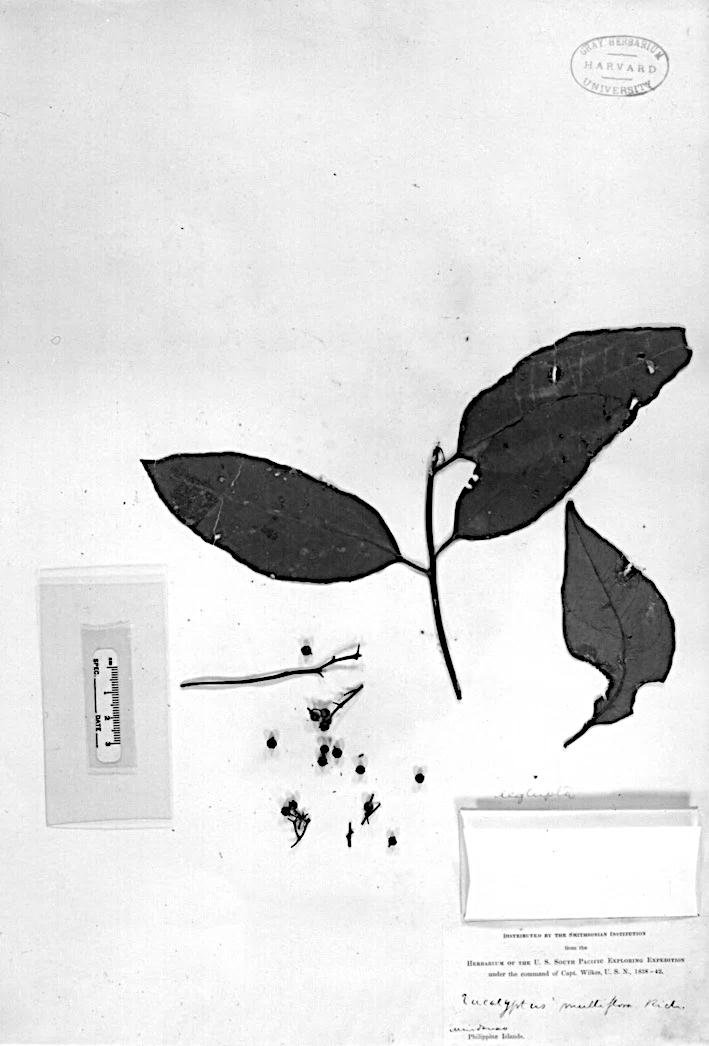
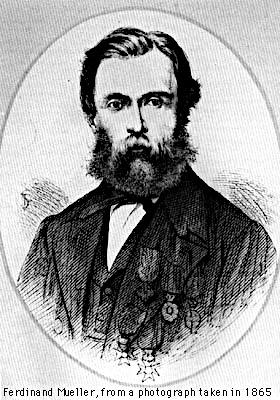
As Blume, Gray, and von Mueller (right) had not seen complete buds with intact calyptra, at least until after initial descriptions were published, there still remained some doubt whether the species described were attributable to Eucalyptus. 20
20 See Maiden J H 1903 Critical Revision of the Genus Eucalyptus, 1(1):12, where E. deglupta was included in a list of 7 “doubtful” eucalypt species.
However, J H Maiden (right) obtained further material including buds and showed later in 1903 that these species were correctly placed in the genus.21 He also stated that the Philippines material (E. multiflora Rich (A Gray)) and that from PNG (E. naudiniana F Muell) represented the same species. As the name E. multiflora was pre occupied22 E. naudiniana was deemed the valid one to be applied to both the Philippines and New Britain specimens.
In 1908 E D Merrill23 (left) provided a photograph of the type specimen of E. multiflora (shown on the next page) and a brief note in the text about it: “Eucalyptus multiflora Rich sp. nov. (p.554). “Hab. Near Caldera, Mindanao, one of the Philippine Islands.” One of the few species of Eucalyptus found outside of Australia, and not as yet rediscovered. It has been reduced by Maiden to Eucalyptus naudiniana F Müll. (Pl.2)”.
In 1909, F R R Schlechter24 (left) collected specimens from near the Waria River in New Guinea. F L E Diels25 (right) in 1922 used one of Schlechter’s specimens as the type of E. schlechteri
21 Maiden J H 1903 On the identification of a species of Eucalyptus from the Philippines. Proceedings of the United States National Museum 26:691 692.
22 E multiflora Poiret, probably a synonym of E. pilularis Smith. See also Blakely W F 1955 A Key to the Eucalypts. Second Edition. Forestry and Timber Bureau, Canberra, and Johnston R D and Marryatt R 1965 Taxonomy and Nomenclature of Eucalypts. Leaflet No 92, Forestry and Timber Bureau, Canberra.
23 Merrill E D 1908 The Philippine plants collected by the Wilkes United States Exploring Expedition. The Philippine Journal of Science 3(2):83 and Plate II p87.
24 Friedrich Richard Rudolf Schlechter (1872 1925) was a German taxonomist, botanist, and author of several works on orchids. He went on botanical expeditions in Africa, Indonesia, New Guinea (twice), South and Central America and Australia. His vast herbarium was destroyed during the bombing of Berlin in 1945, but some duplicates of his specimens survived in other herbaria including Kew in the UK



25 Dr. Friedrich Ludwig Emil Diels (1874 1945) was a German botanist. Shortly before WW I he travelled to New Guinea The majority of his collections were stored at the botanical garden in Berlin Dahlem where they were destroyed during an air raid in 1943. Some duplicates survived in herbaria outside of Germany, such as the isotype of Eucalyptus schlechteri held in the Kew Herbarium (next page)

Merrill’s Plate II of No. 25483, the type specimen of Eucalyptus multiflora Rich (A Gray) held in the Gray Herbarium, Harvard University, Cambridge, Massachusetts, USA. By 1908, it already bore several notations, including the one made by Maiden reducing it to E. naudiniana F von Muell., as referred to by Merrill in 1908.
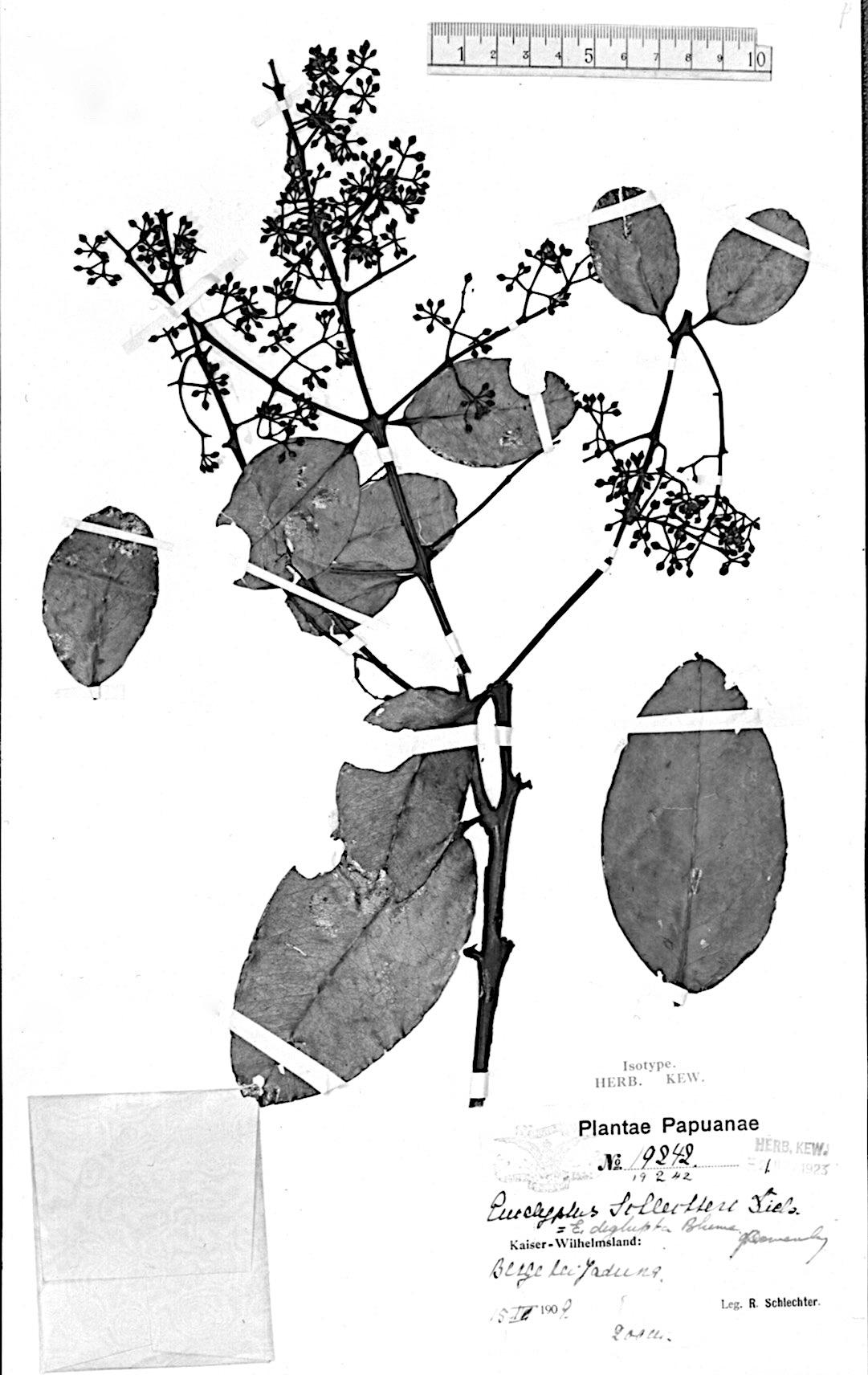

(See also Maiden J H 1903 Critical Revision of the Genus Eucalyptus 2(12):80 81.)
Isotype of Eucalyptus schlechteri Diels (No. 19242, collected in bud on 15 April 1909) held in the Kew Herbarium, UK. Kew photograph received by me in 1967 of a surviving duplicate of the type from Schlecter’s collections. An undated note and signature on the label indicated John Womersley (then Botanist, Division of Botany, Department of Forests, Lae) had inspected this specimen in Kew and equated it to E. deglupta Blume.
A D E Elmer26 collected a specimen near Mt. Urdaneta, Mindanao, Philippines in 1912, which he named Eugenia binacag in 1914. (The spelling of the species name in the description (binacag) is slightly different to Elmer’s spelling (banicag) on the duplicate type specimen held in the Gray Herbarium (see next page) and in two places as well as on the typed label on the Rijks Herbarium’s Duplicate Type specimen (No. 202220, see the page after the next). Elmer later (1915)27 placed this specimen in Eucalyptus.
26 Adolph Daniel Edward Elmer (1870 1942) was an American botanist and plant collector. He made extensive plant collections in the Philippines from 1904 to 1927 He lived much of his life in Manila, Philippines and was editor of Leaflets of Philippine Botany, where he published more than 1,500 new species.
27 Elmer A D E 1914 Myrtaceae Leaflets of Philippine Botany 7:2351, and Elmer A D E 1915 Myrtaceae. Leaflets of Philippine Botany 8:2776.
Isotype (type duplicate) of Eugenia binacag Elmer 13865 held by the Gray Herbarium, Harvard University, USA, and photographed for me in 1967. Attached was a preprinted label with the words “Philippine Islands Plants, Distributed by A. D. E. Elmer. Cabadbaran (Mt. Urdaneta), Province of Agusan, Island of Mindanao, September 1912.” The label and notes show the spelling of the species name in two places as banicag. An unknown person had added the notes ascribing the specimen to “Eucalyptus banicag Elm” and to “[ditto marks?] deglupta Bl”.
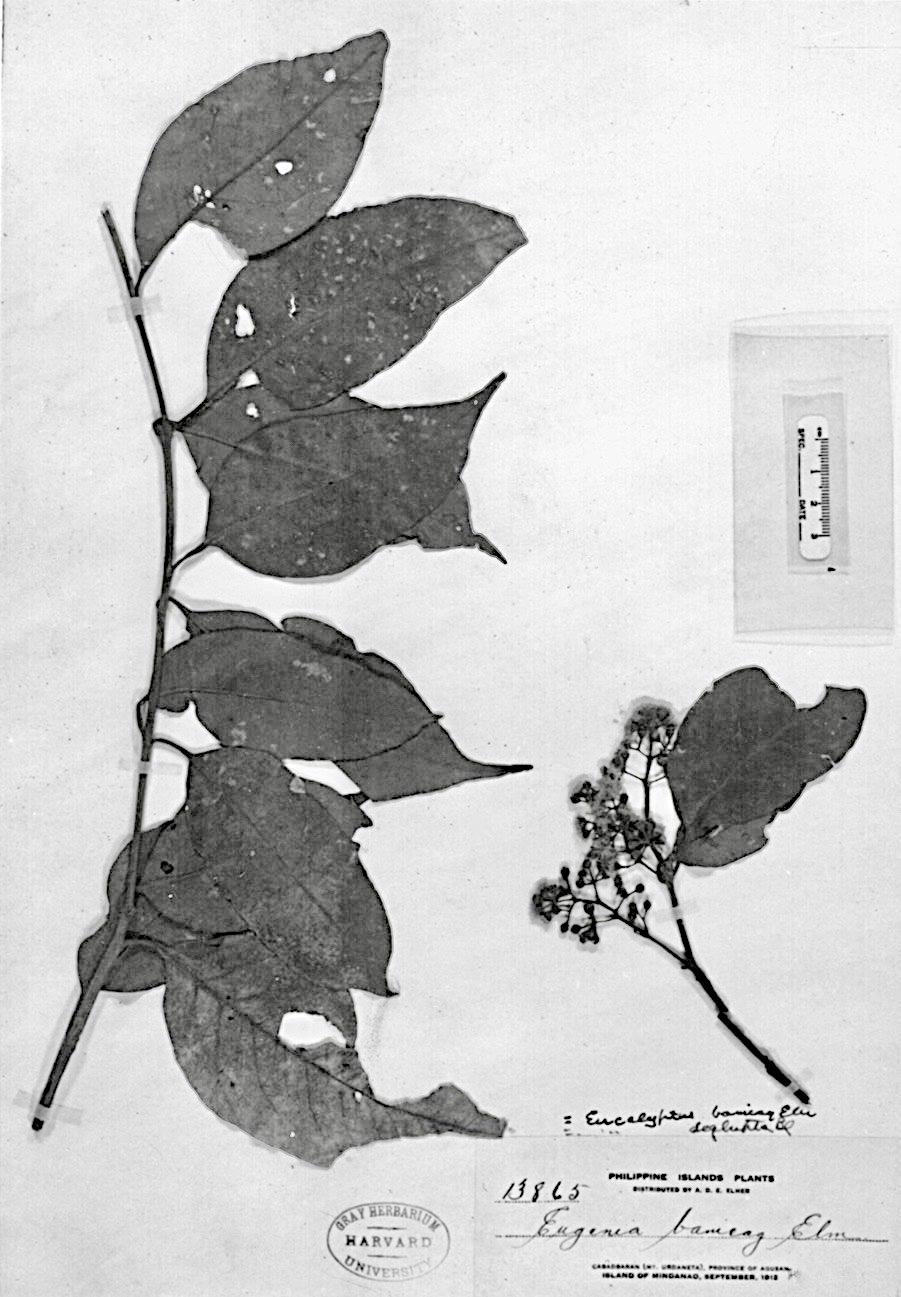
Isotype of Eugenia binacag Elmer 13865 held by the Rijks Herbarium, Leiden, Netherlands, and photographed for me in 1967. Notes by both E D Merrill (“EDM VIII /1920”) and S T Blake (Queensland Herbarium) “9 11 1951” on the labels ascribe the specimen to Eucalyptus deglupta. All the labeling on this specimen shows the name as “banicag”, whereas Elmer’s original description uses the spelling “binacag”, presumably after the local Manobos name.
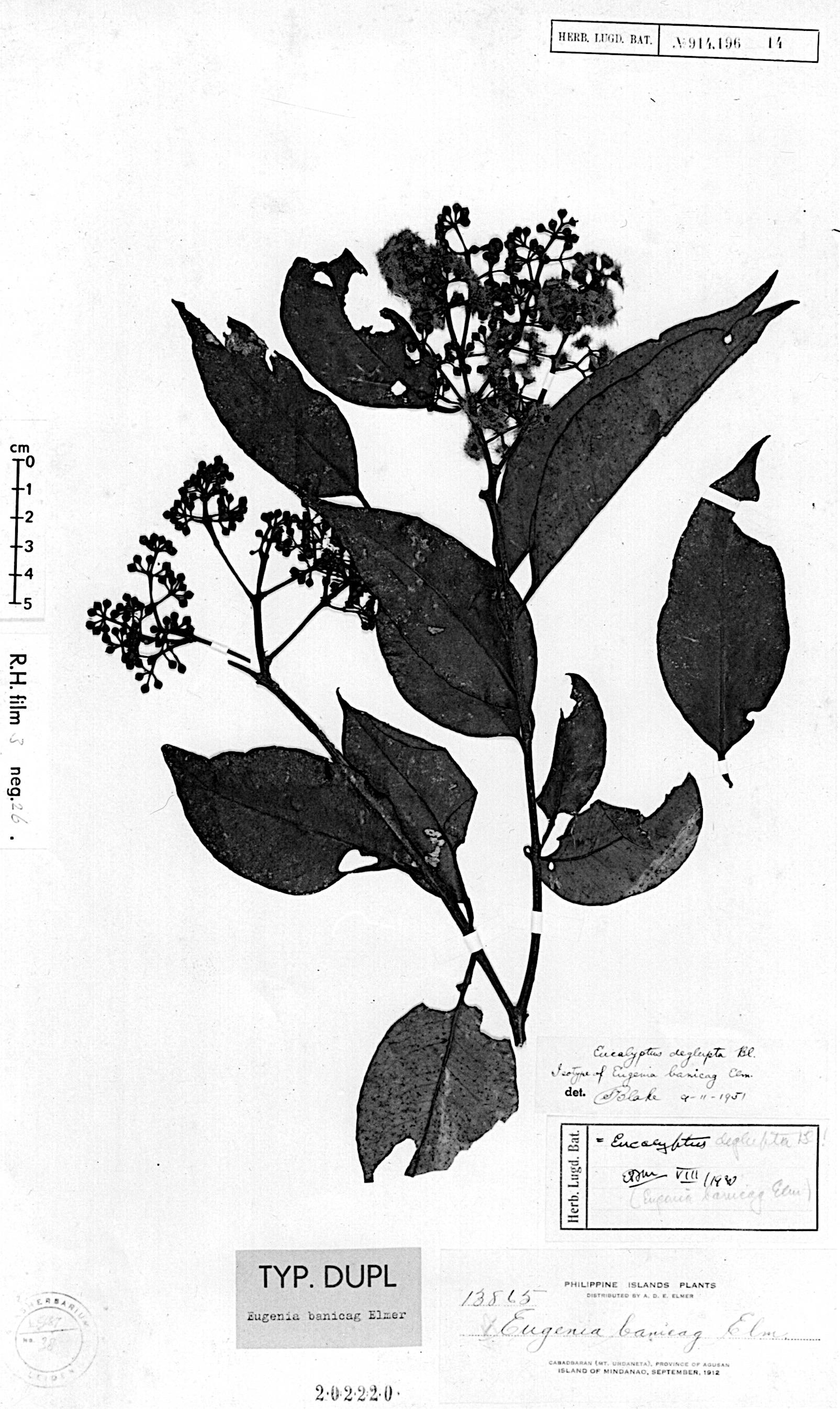
An isotype of Eucalyptus binacag (Elmer) Elmer, in poor condition, held by the National Herbarium of NSW and photographed for me in 1968. The appended notes, mainly by E D M Merrill, trace some of the taxonomic history of this specimen (13865 Elmer September 1912) from Eugenia binacag Elm., through Eucalyptus binacag and Eucalyptus naudiniana F.v.M., to Eucalyptus deglupta Blume, and synonymy with E. multiflora Rich.

Maiden in 191028 accepted E. naudiniana as a separate species and E. multiflora as its synonym (see photographs below and on the top of the next page). He reproduced original descriptions for both species and made a number of other observations, and included illustrations for E. naudiniana. 28 Pages 79 81 In Maiden J H 1910 A Critical Revision of the Genus Eucalyptus. LVI E. Naudiniana F. v. M. Vol II, Part 2, Part XII of the whole work, Government Printer, Sydney.

Photograph of Maiden’s 1910 illustrations for E. naudiniana (Plate 55 (part only shown here). 3a, 3b: leaf shapes; 3c: buds; 3d: anthers; 4: open fruits with four exsert valves).
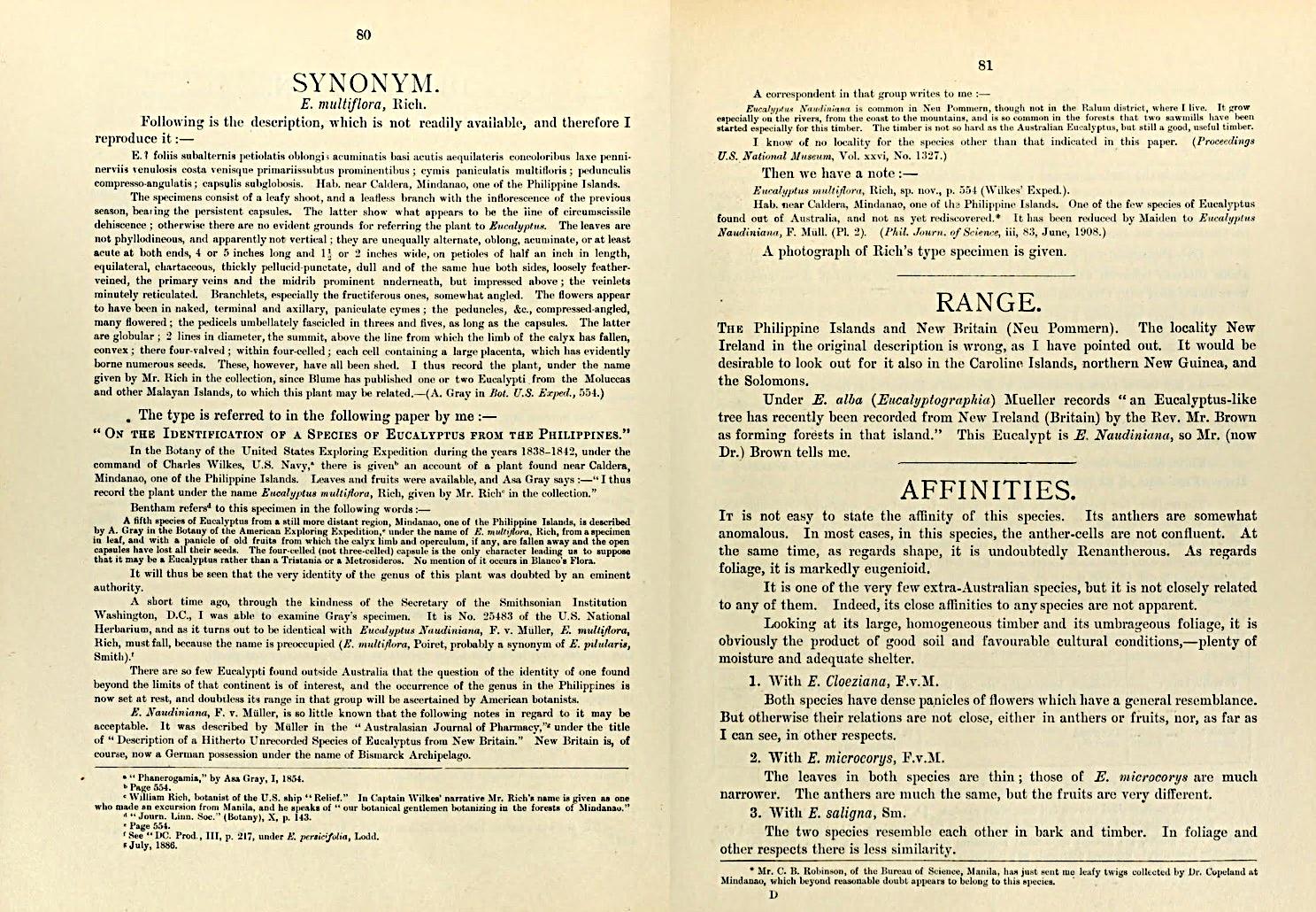

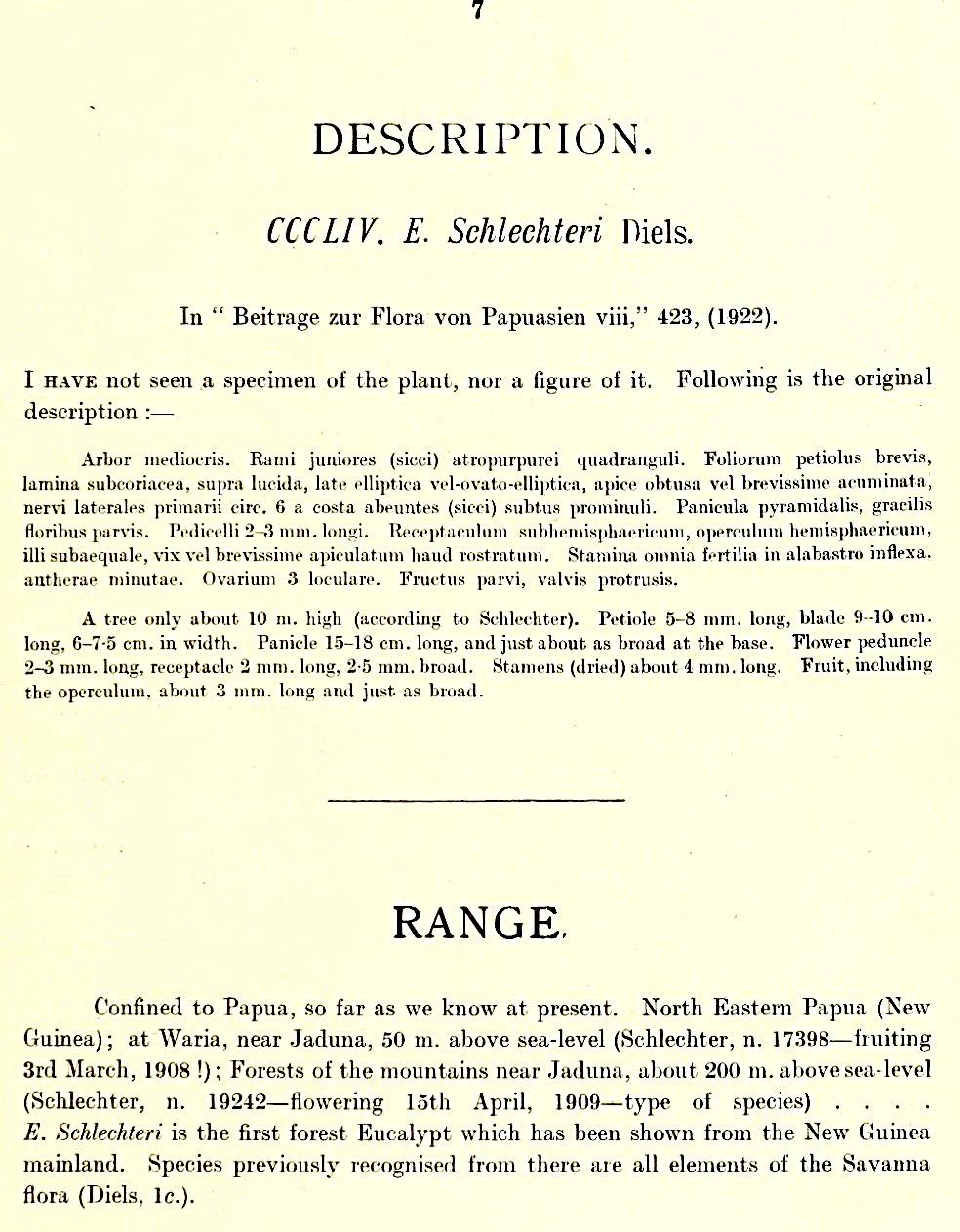

Maiden in 192329 because he had not seen a specimen or figure of it (see photograph of p7 on the previous page), maintained E. schlechteri as a separate species but noted its affinity to E. naudiniana, which he kept as a separate species also (see photograph of p8 on the previous page). At the same time Maiden reproduced Diels’ 1922 key on p8, which included two other eucalypt species from the then Territory of Papua, E. papuana and E. alba.
E D Merrill in 1917 and 1923 published his interpretation of the synonomy of E. deglupta30 , expressing his confidence that Eugenia binacag, Eucalyptus binacag, Eugenia deglupta, Populus deglubata, Eucalyptus deglupta, Eucalyptus versicolor, Eucalyptus multiflora, and Eucalyptus naudiniana, referred to the same species. He stated Arbor versicolor was “unmistakably” Eucalyptus.
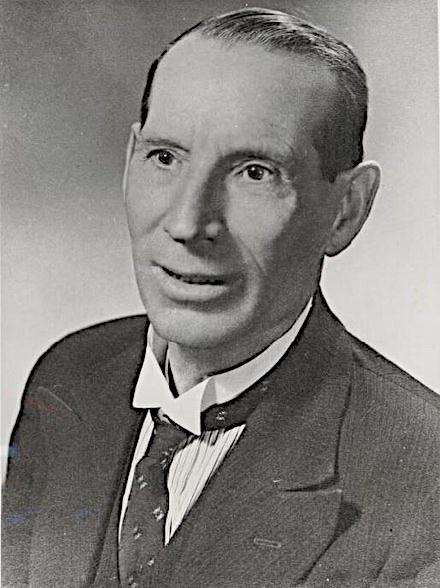
Blakely (below) accepted these findings in 193431 but since he, Maiden and Merrill had not seen any specimen of Eucalyptus schlechteri by that time, it was maintained by them as a separate species.
29 Pages 7 and 8 In Maiden J H 1923 A Critical Revision of the Genus Eucalyptus CCCLIV E. Schlechteri Diels. Vol VII, Part 1, Part LXI of the whole work, Government Printer, Sydney. Note: It was common back then to capitalize the species name if the plant was named after a person, here for example, Rudolf Schlechter (1872 1925) and Charles Victor Naudin (1815 1899).
30 Merrill E D 1917 An Interpretation of Rumphius’ Herbarium Amboinense, Philippines Bureau of Science Publication No. 9:401 and Merrill E D 1923 Enumeration of the Philippine Flowering Plants 3:184.
31 Blakely W F 1934 A Key to the Eucalypts, The Workers Trustees, Sydney. William Faris Blakely (1875 1941) was an Australian gardener, botanist and collector with a special interest in eucalypts J H Maiden recruited him to the Royal Botanic Gardens in Sydney, where he worked as a gardener from 1900 1913 From 1913 to 1940 he worked in the National Herbarium of New South Wales, and with Maiden on Eucalyptus
(Left) Photograph of page 401 from Merrill E D 1917 An Interpretation of Rumphius’ Herbarium Amboinense, Philippines Department of Agriculture and Natural Resources, Manila, Bureau of Science Publication No. 9 On this page Merrill set out his ideas on the synonymy of several taxa with Eucalyptus deglupta Blume
Despite Merrill pointing out the synonymy of E. naudiniana with E. deglupta in 1917, authors like J S Lyng in 1919 and C E Lane Poole in 1925 continued to use the name E. naudiniana.
In 1919, J S Lyng32 wrote: “Seen from the summit of Mount Mother, it appears that patches of grass country is intermixed with patches of forest, the eucalyptus Naudiniana being much in evidence. Towards the south west the view is barred by the blue tinted Baining Mountains which rise to approx. 5,000` [about 1,500 m].”
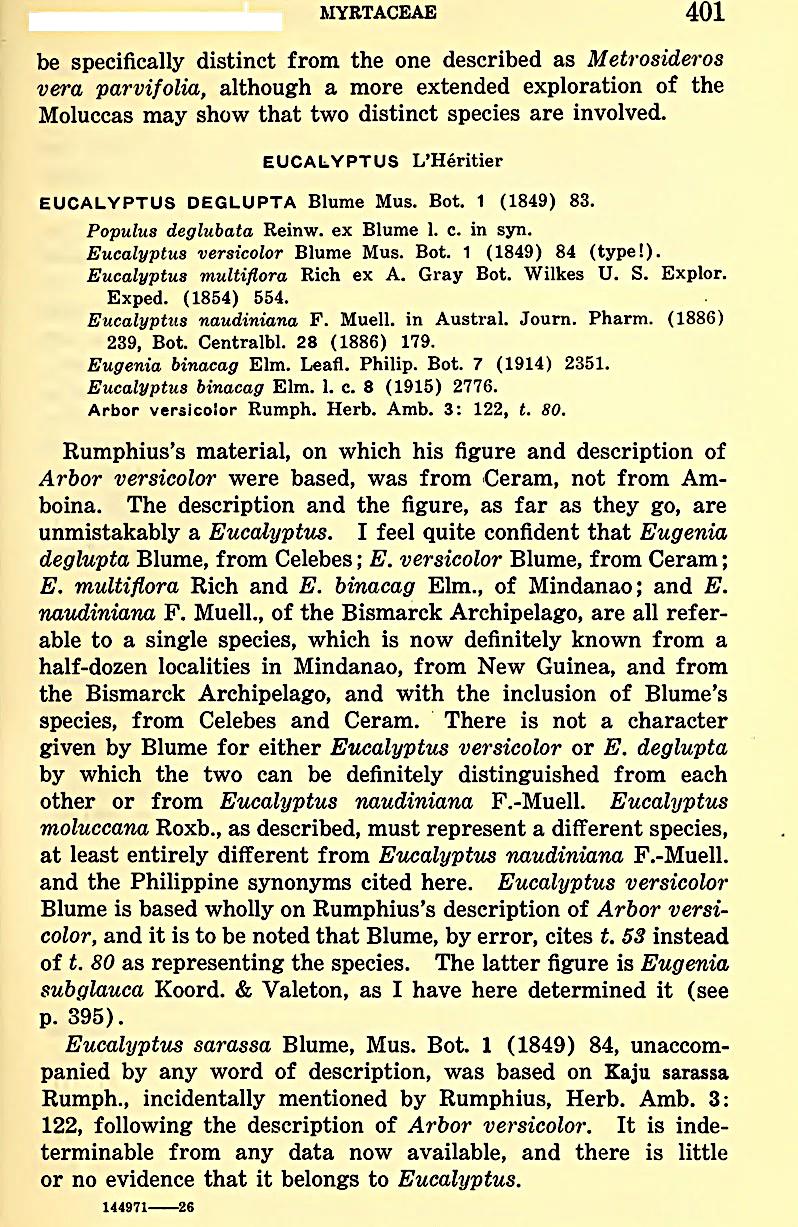
After extensive fieldwork in the Territories of Papua and New Guinea, C E Lane Poole had his findings published by the Government of the Commonwealth of Australia on 13 August 1925.33 He described the Kamarere forest of New Britain in some detail on pages 55 57 using the name “Eucalyptus Naudiniana”. Facing page 56 he included two photographs of the species on the banks of the Powell River, New Britain, though the heading title on that page was misspelt “Eucalyptus Nordiniana”. Lane Poole gave his own description of “Eucalyptus Naudiniana” on page 124 (photograph below right).
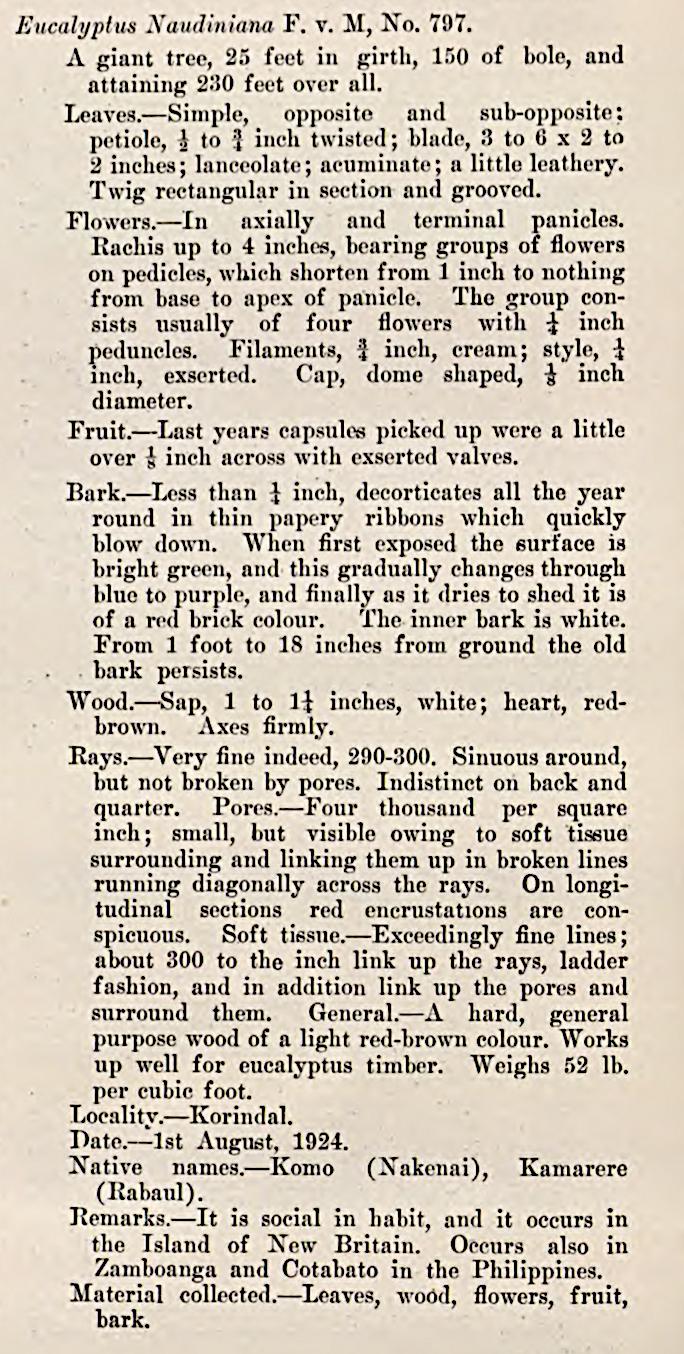

Above: Cover of Lane Poole’s report August 1925.
Right: His description of E. naudiniana on page 124. (1 inch = 2.54 cm; “25 feet” = 7.62 m; “150” feet = 45.7 m; “52 lb. per cubic foot” = 883 kg/m3)
P J Eyma collected a specimen of E. deglupta from the vicinity of the Wissel Lakes34 in the then Netherlands New Guinea on 23 October 1939.
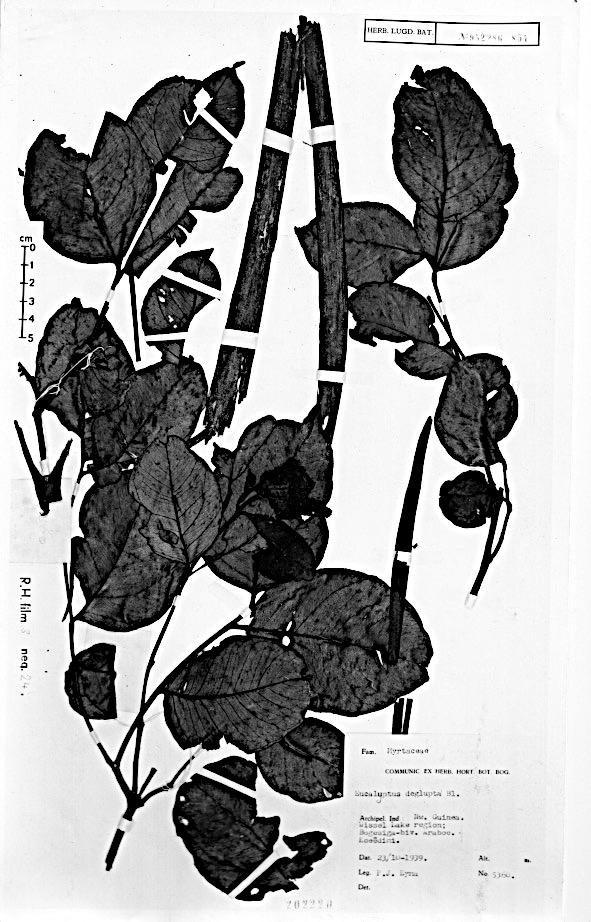
Eyma’s specimen held in the Rijks Herbarium, Netherlands. Photographed by the Herbarium for me in 1967.
In the same year L G Vial35 was reporting on photographing E. deglupta in the Chimbu Valley.
34 Now Lake Paniai, Papua Province, Indonesia.
35 Leigh Grant Vial (1909 1943) was a Patrol Officer, Coastwatcher and RAAF Officer. He was reported to be the first European to climb to the summit of Mt Wilhelm on 15 August 1938. For a time during WW II he was sent out as a Coastwatcher operating in the hills near Salamaua and overlooking and reporting on Japanese activities in occupied Lae. As an RAAF Officer he was on an aerial supply drop mission on 30 April 1943 when the Liberator aircraft carrying him crashed near Bena Bena in the Highlands. All 12 on board were killed. He is buried in the War Cemetery at Lae.
Vial’s photographs of E. deglupta growing in the Chimbu Valley and handwritten notes dated January 1939. This sheet was held by the National Herbarium in Lae and photographed there by me in 1967. The altitude of this Valley is over 1,800 m.

In 1948 and 1949 more specimens were collected from the E. schlechteri type locality along the Waria River, Morobe District and were originally labeled as that species when deposited in the Herbarium Australiense in Canberra. Other reports followed on E. deglupta from Celebes and Ceram.36
36 Ferguson J H A 1949 Eucalyptus deglupta Bl. Rapport Bosbouwproefstation, Buitenzorg [Report of the Forest Research Institute, Buitenzorg (Bogor)] No. 13, 8pp; and, Ferguson J H A 1950 Eucalyptus deglupta Bl., Tectona 40:51 61.
A sterile specimen of E. deglupta collected in 1949 by an unnamed native collector from the type locality of E. schlechteri and labeled as E. schlechteri. This specimen is a duplicate sent from the Herbarium in Lae to the Herbarium Australiense in Canberra. I photographed it in Canberra in 1968, while it was still labeled as “Eucalyptus schlechteri Diels”.
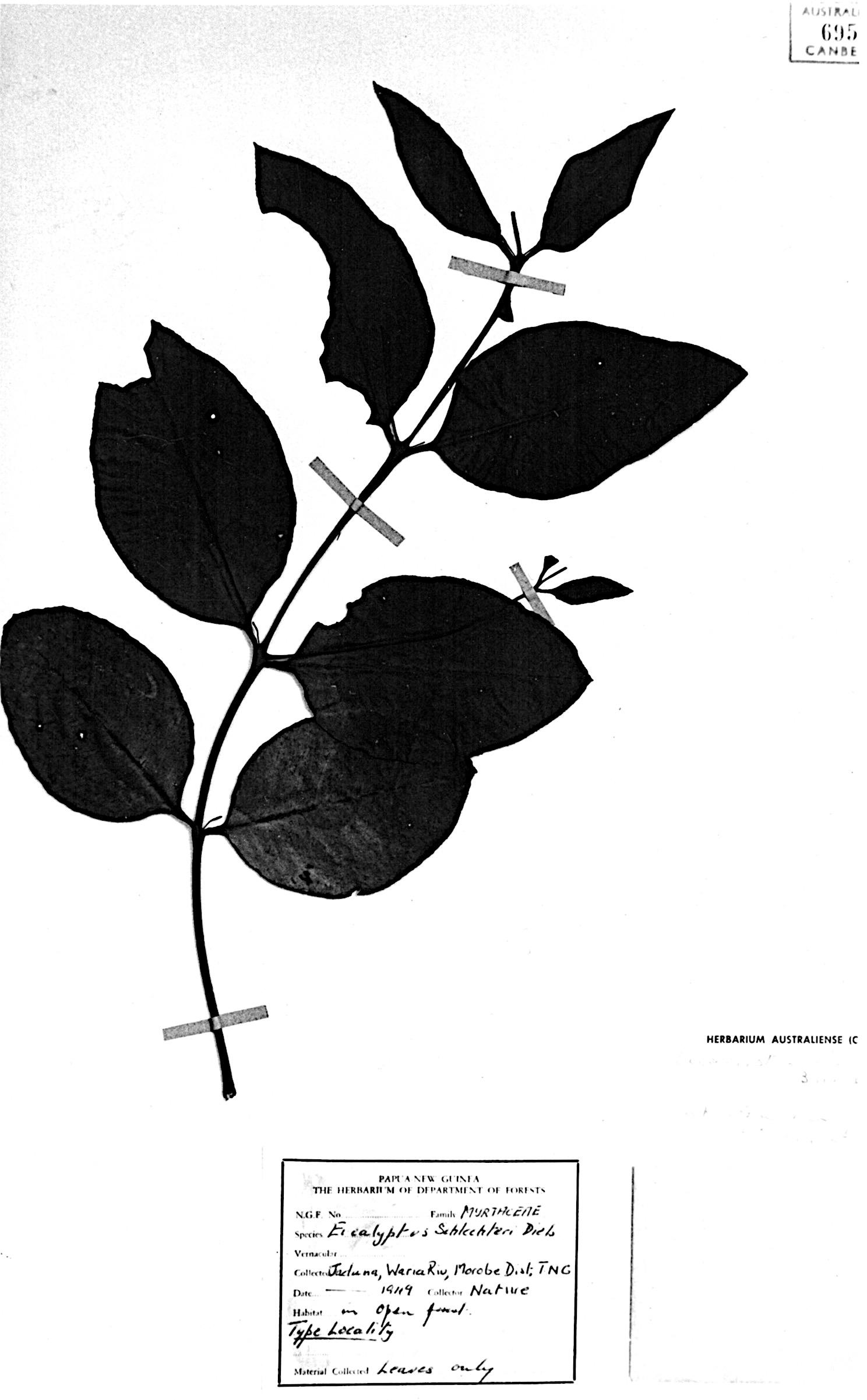
In 1952, J B McAdam provided a second detailed written description of the Kamarere forest of Papua and New Guinea.37 He classified it as one of the three sub-types of coastal and foothill rain forest.
“
(1) KAMARERE FOREST.
Along the rivers of New Britain is found a Eucalypt called Kamarere (E. deglupta). It is very similar to Karri in appearance and size. It sometimes reaches 250` [76 m]. It colonises the new gravel beds of the rivers and is found in almost pure stands sometimes reaching a density of 60,000 super feet to the acre [350 m3/ha]. The timber is excellent for general building out of the weather. Normally the stands are fringing and not extensive, but in one area in the vicinity of the Father volcano, stands
37
are extensive, reaching 3,500` [1,067 m] up the side of the mountain and aggregating 80/100 million super feet [189,000/236,000 m3]. The species is ousted by the Malayan flora, but regenerates vigorously on bare mineral soil. Under plantation conditions, it is making excellent growth, and has been observed to make 53` [16 m] height growth 25`` [63.5 cm] GBH in 2½ years. It promises to play an important part in the managed forests of the future. Fortunately, the soils occupied by this species are not sought by the agriculturist.”
W A Heather in 195538 expanded on McAdam’s description with a very comprehensive account of the species in seven different associations on the island of New Britain.
In 1960 and 1961 two more collections were made from the then Netherlands administered New Guinea, now the Indonesian Provinces of Papua and West Papua. One was a further collection from the Wissel Lakes (now Lake Paniai) area this time by J F U Zieck39 on 22 May 1960 in steep mountain forest at 1,850 m above sea level near Kebo. The other was from Mt Nettoti in Conifer Nothofagus forest on the Vogelkop Peninsula by P van Royen on 30 November 1961.
Left: Zieck’s specimen from near Kebo, Wissel Lakes, originally in the Forestry Division Herbarium, Netherlands New Guinea, but photographed in the Herbarium Australiense, Canberra by me in 1968.
Right: Van Royen’s specimen from Mt Nettoti in the Rijks Herbarium, Leiden, and photographed by the Herbarium for me in 1967.
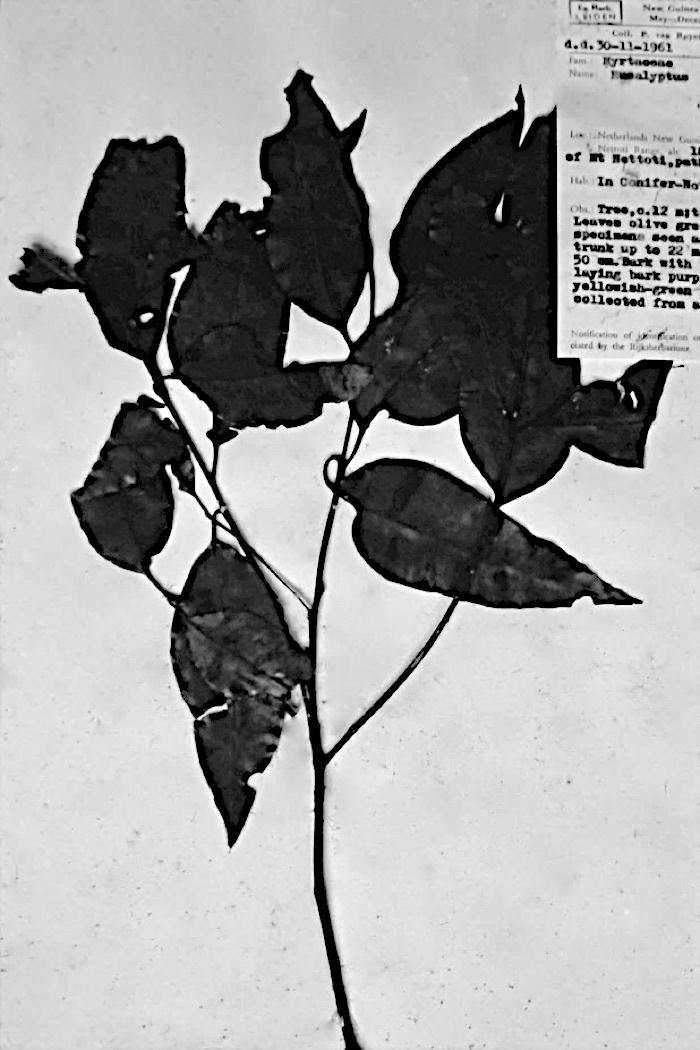
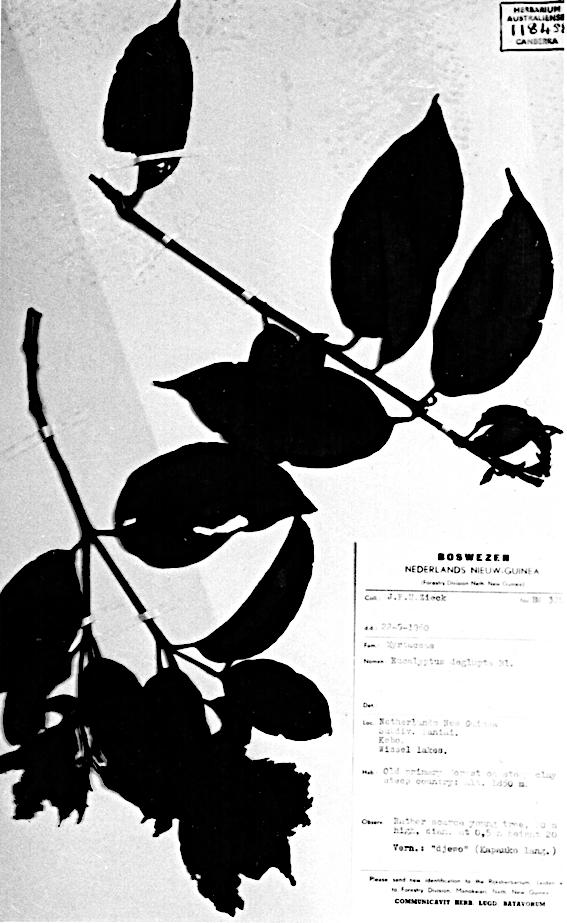
38 Heather W A 1955 The Kamarere Forests of New Britain. The Empire Forestry Review, 34:255 278.
39Mr J F U Zieck later came to PNG and worked in the Division of Forest Products, Department of Forests, in the early 1970s.
Specimens of E. deglupta from Ossima Village, Sepik District, collected by D Sayers on 9 March 1964. Photographed by me in 1968 at the National Herbarium in Lae. According to the label, duplicates were distributed to several of the World’s herbaria.

Specimens of E. deglupta collected from Unai River, Fullerborn Harbour, Kandrian, New Britain in March 1965 by D Sayers. A note by J Womersley dated 24 August 1968 endorses the identity of the specimen as E. deglupta Photographed by me at the National Herbarium in Lae in 1968.
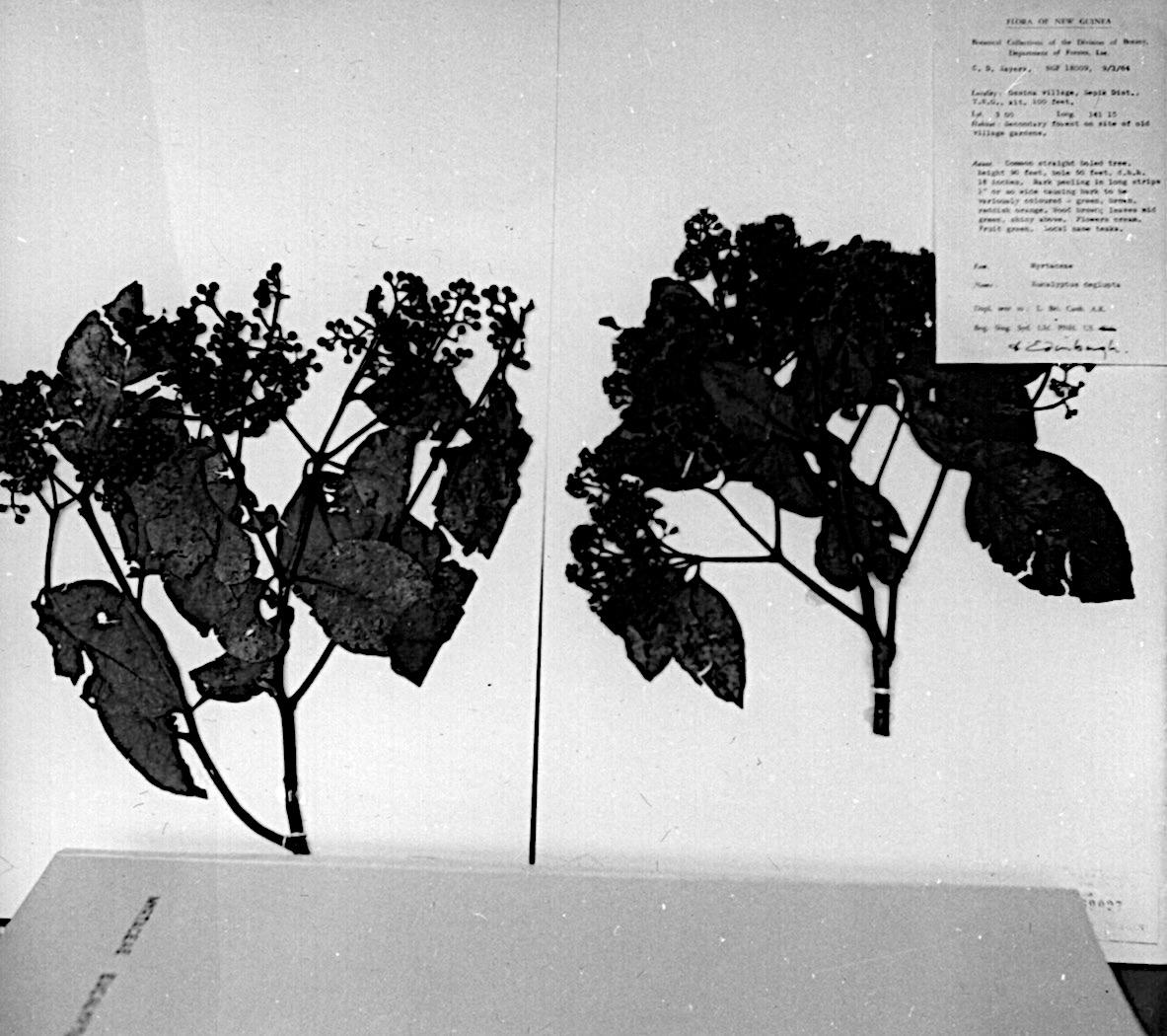
In 1964, the Forestry and Timber Bureau, Canberra, produced a revised edition of its 1954 Hall & Johnston Card System for the Identification of Eucalyptus Species. This is the card for E. deglupta Blume (Blakely Number 437), which now recognised E. naudiniana F. Muell. as a synonym, and included E. schlechteri, which still had a separate number and description immediately preceding it (436) in Blakely’s A Key to the Eucalypts, but no separate card for it was included in this system.


David Sayers collected E. deglupta from the Sepik and New Britain in 1964 and 1965. My inspection and photography of these in the National Herbarium in Lae in 1968 (see page 26) brought my initial exploration phase for E. deglupta to a close.
In mid 1967, Mr W R Suttie, then Director of the Department of Forests, called for the preparation of a paper on the improvement of Kamarere for presentation to the Ninth Commonwealth Forestry Conference planned to be held in New Delhi India 3 27 January 1968. I was requested to prepare the paper. Given the very early stage that the research programme on E. deglupta was at, the most that could be done was to present what little was already known about the species40and to outline my proposed programme.
My paper included tree growth data from Suttie’s 1961 paper and some preliminary work done by Cameron in 196641 on basic density and fibre length.
Graphs for height growth over time, as well as basic density and fibre length with distance from the pith, for E. deglupta were prepared at Keravat for inclusion in my paper for the Ninth Commonwealth Forestry Conference. [1 ft = 0.3 m; 1 in = 2.5 cm; 1 lb/cu ft = 16 kg/m3]



40 Among the published accounts up until that date were: Womersley J S and McAdam J B 1957 The Forests and Forest Conditions of the Territories of Papua and New Guinea prepared for the Seventh British Commonwealth Forestry Conference, Australia and New Zealand 26 August 10 October 1957; Suttie W R 1961 Eucalyptus of the Territory of Papua and New Guinea, Second World Eucalyptus Conference, São Paulo, Brazil, 13 26 August 1961; Suttie W R 1962 Forestry in Papua and New Guinea A Transition Period 1951 1961, Presidential Address to the Papua and New Guinea Scientific Society, March 1962; Department of Forests 1966 Silvicultural Techniques in Papua and New Guinea Forest Plantations. Bulletin No 1, 2nd Edition, Government Printer, Port Moresby.
41 Cameron A L 1966a Basic density determination Kamarere. Preliminary Report No. 105.11.10/30 Department of Forests, Territory of Papua and New Guinea; Cameron A L 1966b Fibre length determinations Kamarere. Preliminary Report No. 105.11.10/67 Department of Forests, Territory of Papua and New Guinea.
In my Conference paper the initial grafting trial work was mentioned as the start of work on a genetic improvement programme. A programme was proposed to determine appropriate economic procedures for the establishment and maintenance of large scale plantations of E. deglupta with the primary objective of cellulose supply to pulp industries. Studies were to be wide ranging and include silvicultural, management and utilisation components. My stated expectation (on page 7 of the paper) was that the selection and use of individual clones of E deglupta would lead to greatly improved productivity and pulping qualities. Graphs and typescript were sent to Port Moresby for approval and typesetting by the Government Printer.


The seeds of E. deglupta are minute, numbering 1 7 million, sometimes to 14 million, viable seeds per kg. The seeds are shed along with “chaff” comprising the aborted ovules and fragments of placentas (left, about X2). Each fully developed seed is elongate, flattish, with a characteristic tail like terminal wing. The hilum is ventral. Authors up until this time describe the dispersal of seed by water to be deposited downstream on sand and gravelly banks to germinate profusely initially forming dense regeneration (below left and right).
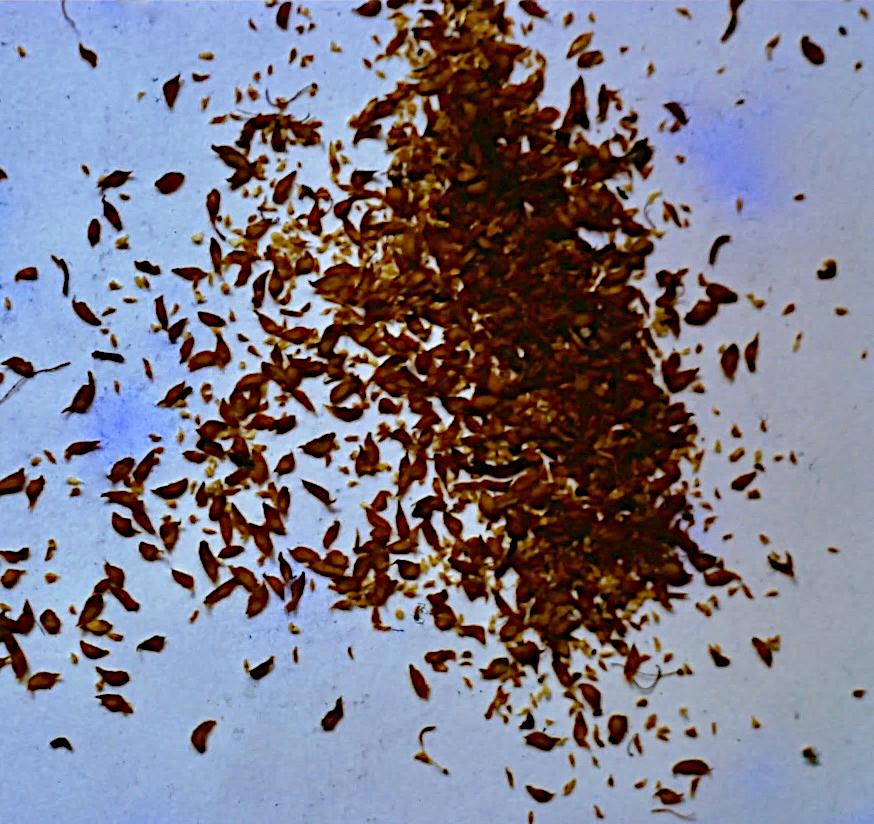
Self thinning takes place and several even aged cohorts may be present at a particular location (right).
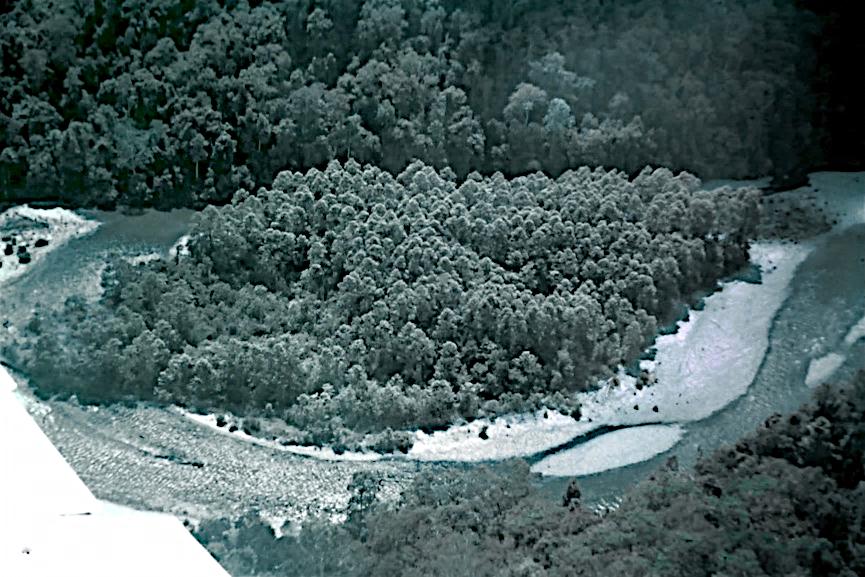
I believed that the lightness of the individual seed and its terminal wing gave it unique properties not found with the seed of other eucalypts. Seeds of E. deglupta were capable of relatively wide dispersal from individual parents at and above canopy level through being carried by wind. Also, being easily carried by wind currents explains how the species was able to colonize, in an uphill direction, new volcanic materials ejected by active volcanoes. Seeds were carried by updrafts generated during the eruptions, as distinct from being carried downhill by flowing water. So, dispersal was both uphill and downhill on volcanic crater cones.
Mount Ulawun is a basaltic and andesitic volcanic cone built up of alternate layers of hardened lava, pumice and volcanic ash. It is situated on the island of New Britain, in West New Britain Province, Papua New Guinea. It is about 130 km southwest of Rabaul, the highest mountain in the Bismarck Archipelago at 2,334 metres, and one of the most active volcanoes in Papua New Guinea. The lower cone is clothed in almost pure stands of E. deglupta in several age cohorts. Natural regeneration occurs in both an upward direction on new deposits through seed borne on updrafts and downward on the lower slopes where seeds are deposited by water along the edges of the numerous incised rivulets. Brown patches are areas destroyed by fire during recent eruptions only to be recolonised later Some palms are associated with stunted E. deglupta at the higher elevations. Casuarina sp coexists with E. deglupta at the lower elevations.

Being able to be carried on volcanic updrafts to high altitudes may at least partly explain how this eucalypt travelled northwards along the western margin of the “Pacific Ring of Fire” from New Guinea to Mindanao in the southern Philippines in the opposite direction to what Lane Poole postulated in 1925.
42

By 1967 not much had changed from the methods of regeneration described by Heather in 1955.43 The main changes had been the adoption of plastic germination trays and use of black plastic polythene tubes instead of metal ones. Soil for the seed flats was still being sterilized by heating for 24 hours on a steel plate over an open fire. Damping off was still a problem and still treated with a spray of Bordeaux mixture.44 The main changes introduced by me were to use less toxic copper oxy chloride, a wettable powder, as a pre emergent pre emptive fungicide and to sit the seed flat in shallow water to allow moisture to seep up from below rather than periodically spraying water on the emerging seedlings and soil surface from above which seemed to increase the likelihood of damping off.
Seedlings were lifted from the trays and tubed when they were still very small, 2 3 cm tall, and less than three weeks after germination. They were pricked out with a small dibble stick into black plastic tubes containing a clay loam soil. The tubes were held upright in wire mesh (left). Low overhead shade was provided by bamboo slats, initially full shade, but then progressively reduced over two to three months by spacing out

42
page 54, in reference to E. naudiniana (a
E. deglupta
states “… it may have found its way south from the Philippines, but it certainly has not come north west from Australia.”
43Heather W A 1955 The Kamarere Forests of New Britain. Pages 264 265 In The Empire Forestry Review, 34:255 278.
44 Bordeaux mixture is a mixture of copper sulphate and slaked lime for use as a fungicide. The mixture was best prepared fresh before each use. It was somewhat toxic to humans if misused.
the slats. Seedlings were in full sunlight ready for planting when 25 to 30 cm tall (in 60 to 90 days).
In 1967 trials were conducted to determine if seedlings could be dibbled into a clay loam soil in beds without tubes then lifted and carried to the field for planting as bare rooted or stumped stock. These trials were all failures. Some success was achieved by tubing wildlings from among the young and dense natural regeneration that was occurring on stream banks. However, this had several disadvantages. One was that the naturally occurring young seedlings were likely to be a long distance from the nursery and/or planting area and prone to transplanting shock. A second was that the pedigree of the seedlings was unknown and performance variable. A third was that this method denied the use of genetically improved seedlings and cuttings of improved varieties that would be derived from a breeding programme.
Seedlings growing in a nursery bed one month after dibbling out. One issue was the enormous variation in size compared with tubed stock. A second was that survival was poor after lifting and carrying the bare rooted or stumped plants to the field.

Finding a successful grafting method was a prerequisite to establishment of a clonal seed orchard. Several methods were tried including top cleft, bottle and patch grafting. Air layering (marcotting) and approach grafting were ruled out for obtaining grafts from tall trees, because the graft would have to be started up in the canopy in situ, requiring elaborate scaffolding, but could be considered later near ground level for multiplying pollarded trees already in an orchard.
Bottle graft of E. deglupta at Keravat in 1967 The scion (on the right) is approach grafted for part of its length to the potted stock of similar diameter. Most of the leaf area of the scion has been removed. The freshly cut base of the scion is left free and immersed in water in the test tube. Trials showed bottle grafting was feasible with young material. Results were less encouraging with scions that were harvested from the canopies of mature trees of 15 years of age or older.
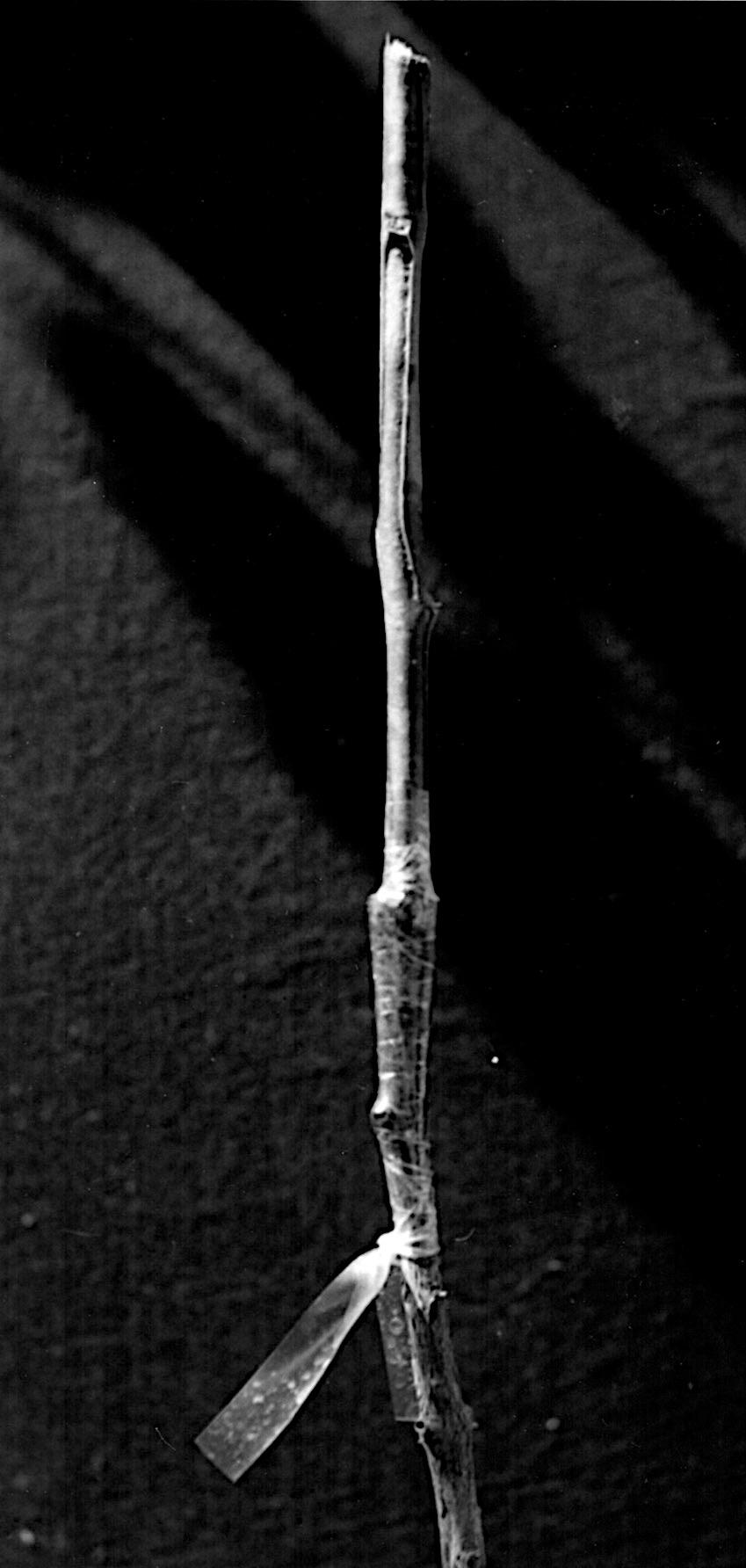

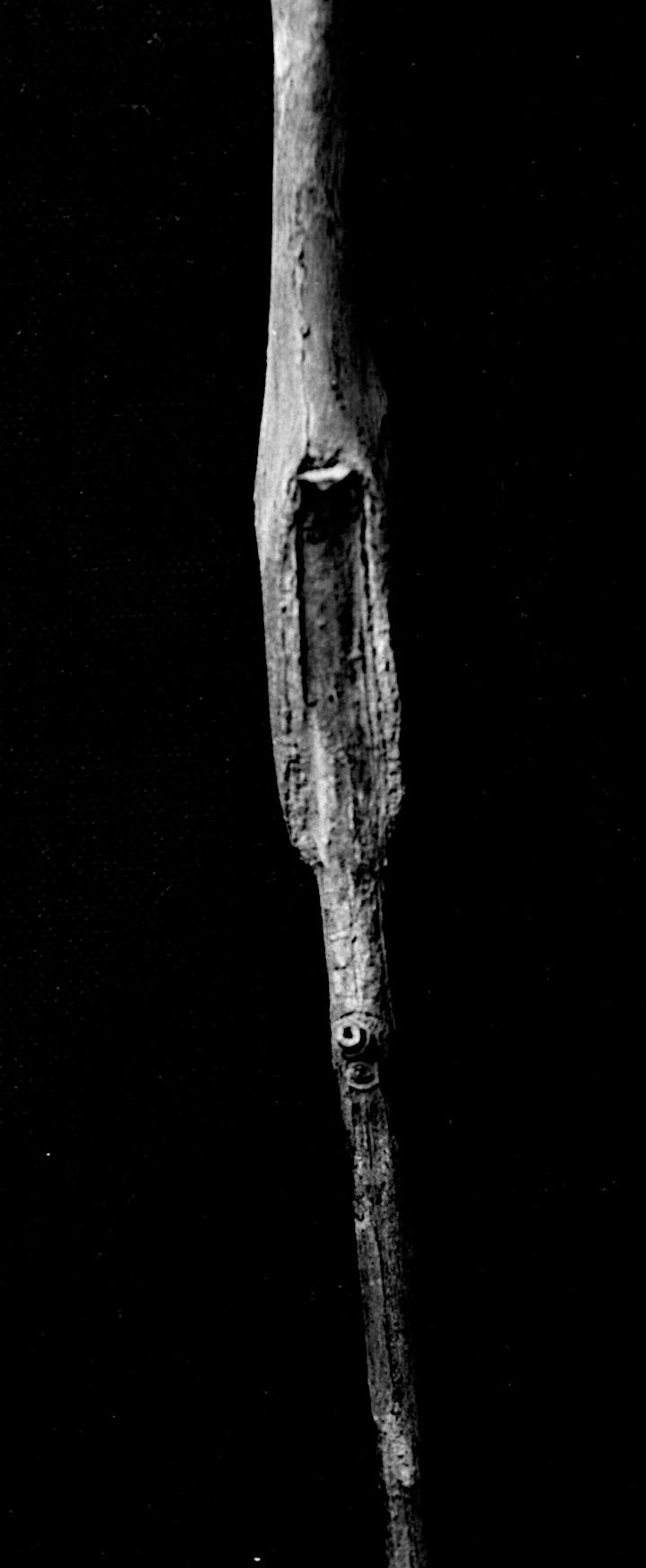
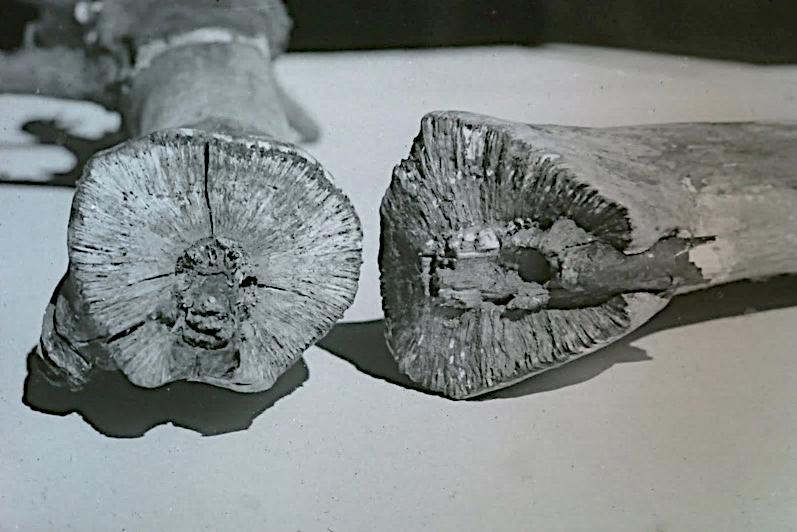
It seemed that the scion material harvested from the canopies of mature trees was having an antagonistic effect when grafted onto the seedling stocks. The hypothesis I developed was that improved success rates could be achieved if the adult scion material was minute in volume compared with the seedling stock that was to carry it. A method was devised whereby a very small patch containing one or more dormant buds
Top cleft grafts of E. deglupta. Left: Scion (top) inserted in the stock (bottom) of similar diameter and with tape on just after grafting. Middle: Early incompatibility, with the scion outgrowing the stock. Right: Successful graft with equal growth in diameter of the scion and stock and good fusion between the two (diameter here about 1.5 cm). Results were generally disappointing with scions harvested from the canopy of mature trees. There were more incompatible unions than there were compatible ones.
Incompatibility in a top cleft graft of E. deglupta at a later stage (shown here about actual size), where the phloem tissues of the stock (left) have refused to join up with the phloem and xylem of the scion (right) to form the linear and vertically orientated tissues necessary to efficiently transport water and nutrients up and down the stem. Instead, they have become transversely oriented at the union interface and are therefore largely incapable of the rapid vertical transport of water and nutrients, leading to the eventual death of the grafted plant, as well as being a point of weakness where breakage could occur easily as is shown here.

could be removed from the scion material harvested from the crowns of mature trees and transferred to a matching internode site prepared on the stem of a young seedling. This had the added advantage that the cambium on the patch more easily matched up with the cambium of the stock and there was no requirement to match the diameters of the scion and stock exactly as was necessary in the top cleft and bottle grafts.
Top left: A small rectangular patch containing one or more dormant buds is removed from the scion by cutting around it down through the cambium and peeling it away from the wood underneath. Top right: The patch is offered up to an internode region of the stock and a cut is made carefully around it, so that the two will match in size (only a razor blade was available for this work at the time!). Bottom left: The rectangular bark patch is removed from the stock down to the wood. Bottom middle: The bud patch from the scion is fitted into the rectangular void on the stock (seen at the bottom edge of the photograph) and bound in place with clear non adhesive grafting tape. It does not matter that the bud area is completely covered by the tape at this stage. Bottom right: The tape is removed after the cambia fuse. Soon after the removal of the tape one or more shoots will emerge from the dormant bud strand(s) in the patch.


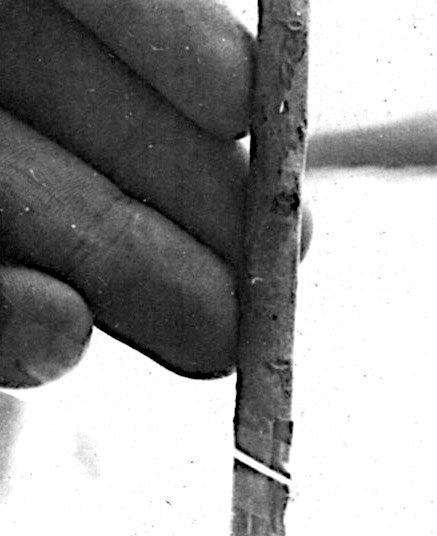


Top left: A single shoot emerging from a patch, Top right: Two shoots emerging from a patch. At this stage the stock is still growing normally above the graft to provide life support. Left: Two branches that have developed from a single patch. The stock has been decapitated about 10 cm above the graft and the grafted scion with its developing foliage has taken over the role of life support enabling the graft to be planted in the field.
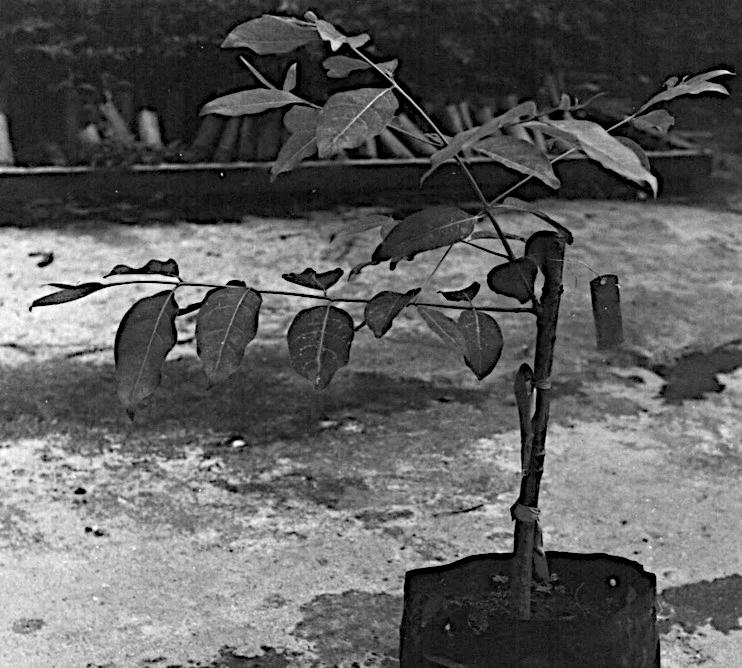
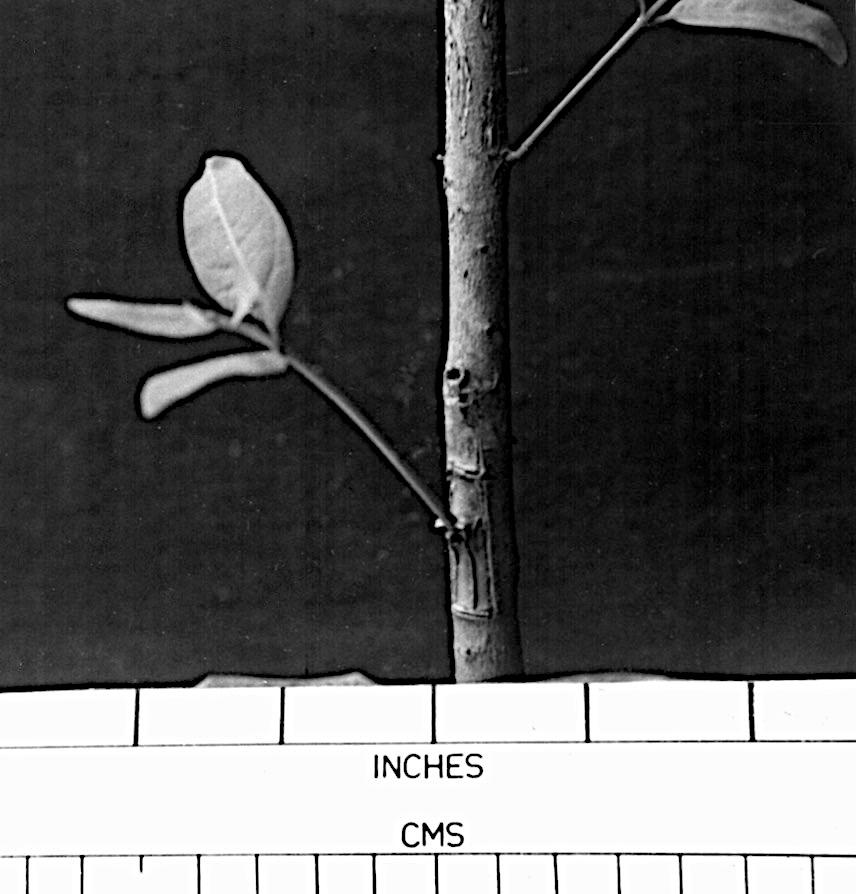
In E. deglupta, as in all eucalypts, bud producing tissue is situated in the inner side of the bark at the end of the epicormic bud strand.45 The strands originate in leaf axils from the meristematic tissue between the naked bud and the petiole, and grow radially outward at almost exactly the same rate as diameter growth of the stem. These buds are normally held in check by the inhibiting effect of hormone substances produced in the leaves and young shoots. They lie dormant until stimulated to shoot by the removal of the scion from the tree canopy and, in turn, the removal of the patch from the scion. There is potentially at least one dormant bud for every leaf that the tree has ever carried. In some cases the bud strand divides such that there is the possibility that more than one shoot will be produced from a single patch. Also the meristematic tissue in the bud strand itself through mitotic division is capable of producing more than one shoot at a patch graft site. 45 Pages 16 and 17 and Section 9 pages 49 54 in Jacobs M R 1955 Growth Habits of the Eucalypts. Forestry and Timber Bureau, Canberra. 262 p.
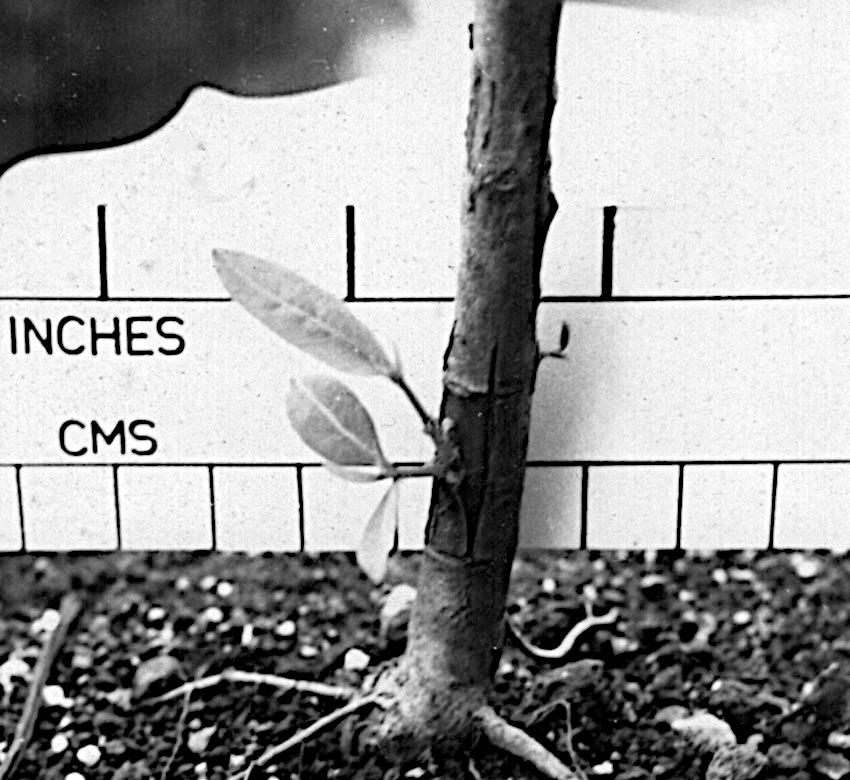
Propagation of superior genotypes of older trees by cuttings would allow marked gains in genetic quality of plantations. There were some early indications that cuttings of E. deglupta might be successful through observations that roots had formed on adult stems of other Eucalyptus species following flooding or natural layering,46 from experimental air layering, and from the observed formation of aerial roots on plantation trees of E. robusta in Hawai`i.47 L J Brass on a specimen sheet in the Lae Herbarium (30764) collected from the eastern slopes of Mt Wilhelm on 29 July 1959 wrote “said to be propagated by cuttings”. Aerial roots were observed at Keravat on the lower stems of E. deglupta growing both in swampy conditions and when tree bases were buried in fresh volcanic ash, offering encouragement that cuttings might be successfully propagated for this species.
Aerial roots on the base of stems of E. deglupta at Keravat. The diameter of these stems is about 10 cm.

46 Jacobs M R 1955 Growth Habits of the Eucalypts. Forestry and Timber Bureau, Canberra. 262 p.
47 Pryor L D 1957 A practical method for the vegetative propagation of Eucalyptus Proceedings of the Linnean Society of NSW 82:199 200; Pryor L D and Willing R R 1963 The vegetative propagation of Eucalyptus: an account of progress. Australian Forestry 27:52 62.
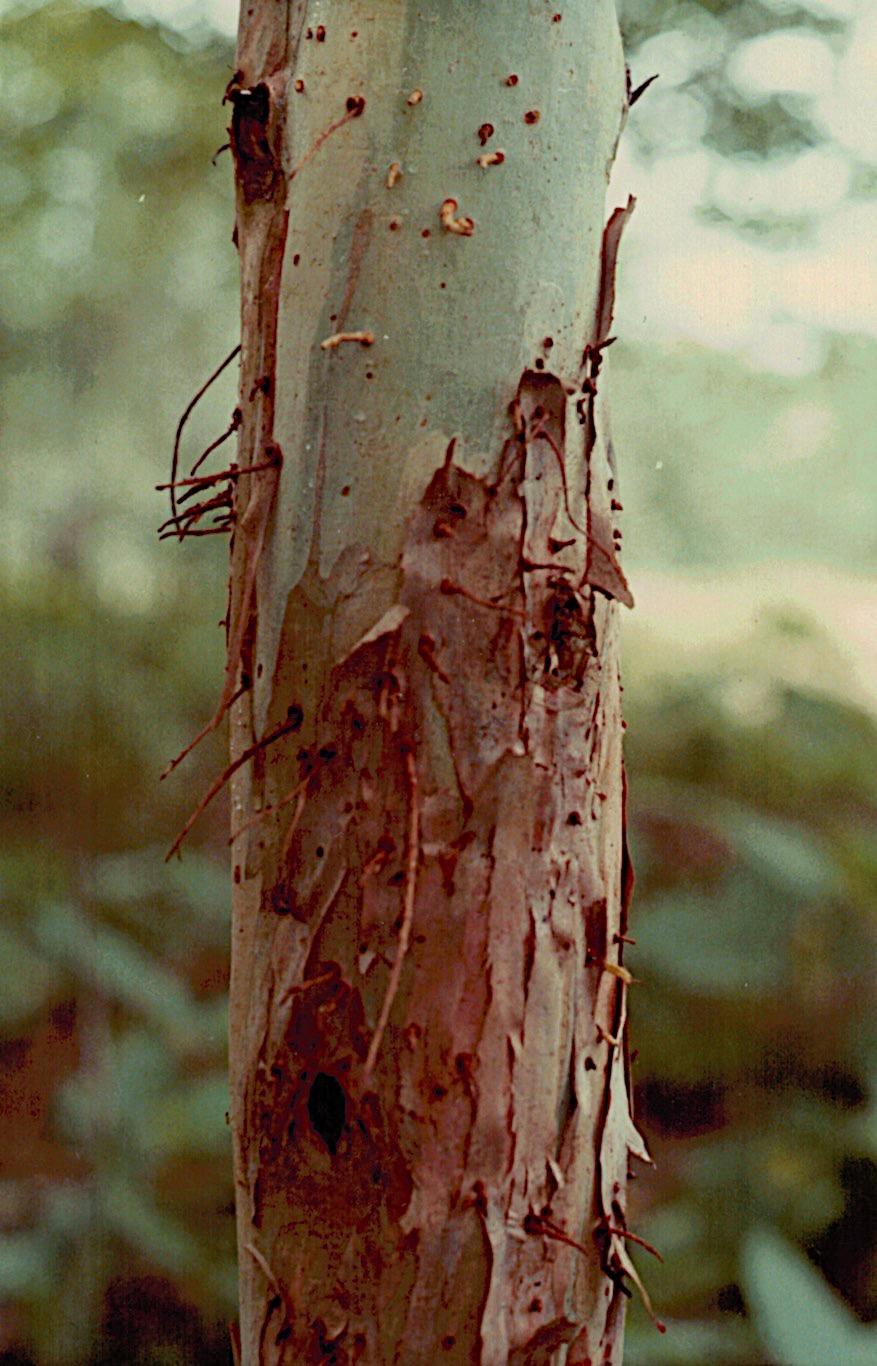
The first cuttings of E. deglupta grown by me at Keravat comprised the upper half of three month old seedling stems pushed into sandy loam, kept in the shade and watered twice daily without mist spraying and without the application of rooting hormones. Roots emerged in 5 to 9 days.
With the arrival of misting equipment it was possible to set up a mist propagation facility next to the grafting shed at Keravat. Electricity was provided by an overhead extension from the office. Walls were plastic sheet over chicken wire and the mist nozzles were installed above locally constructed waist high slatted wooden benches. The roof was thick translucent plastic sheet.

Early trial of cuttings of E. deglupta under mist spray at Keravat in 1967. At the top are cuttings of various ontogenetic ages standing in water. The aluminium foil around the transparent plastic cups kept out the light. The foil covers, which were sealed around the cutting with grafting mastic, prevented additional water from the misting flooding into the cup. Nearest the camera are cuttings in waxed paper cups with drain holes pierced in the bottom and filled with a 2:1 mixture of vermiculite and peat. These methods allowed various experiments to be conducted on cuttings prepared from trees of varying age and treated with the hormones indole acetic acid (IAA), indole butyric acid (IBA) and naphthalene acetic acid (NAA) in concentrations of 10 30 parts per million (ppm).
The addition of root promoting hormones increased the success rate of rooting and shortened the time between cutting installation and first roots forming from a range of 5 to 9 days to consistently better than 5 days. Cuttings from plants of ontogenetic age of three months and less were rooted with 99% success. The success rate was still at 95% for twelve months old material. Overall, E. deglupta was shown to be
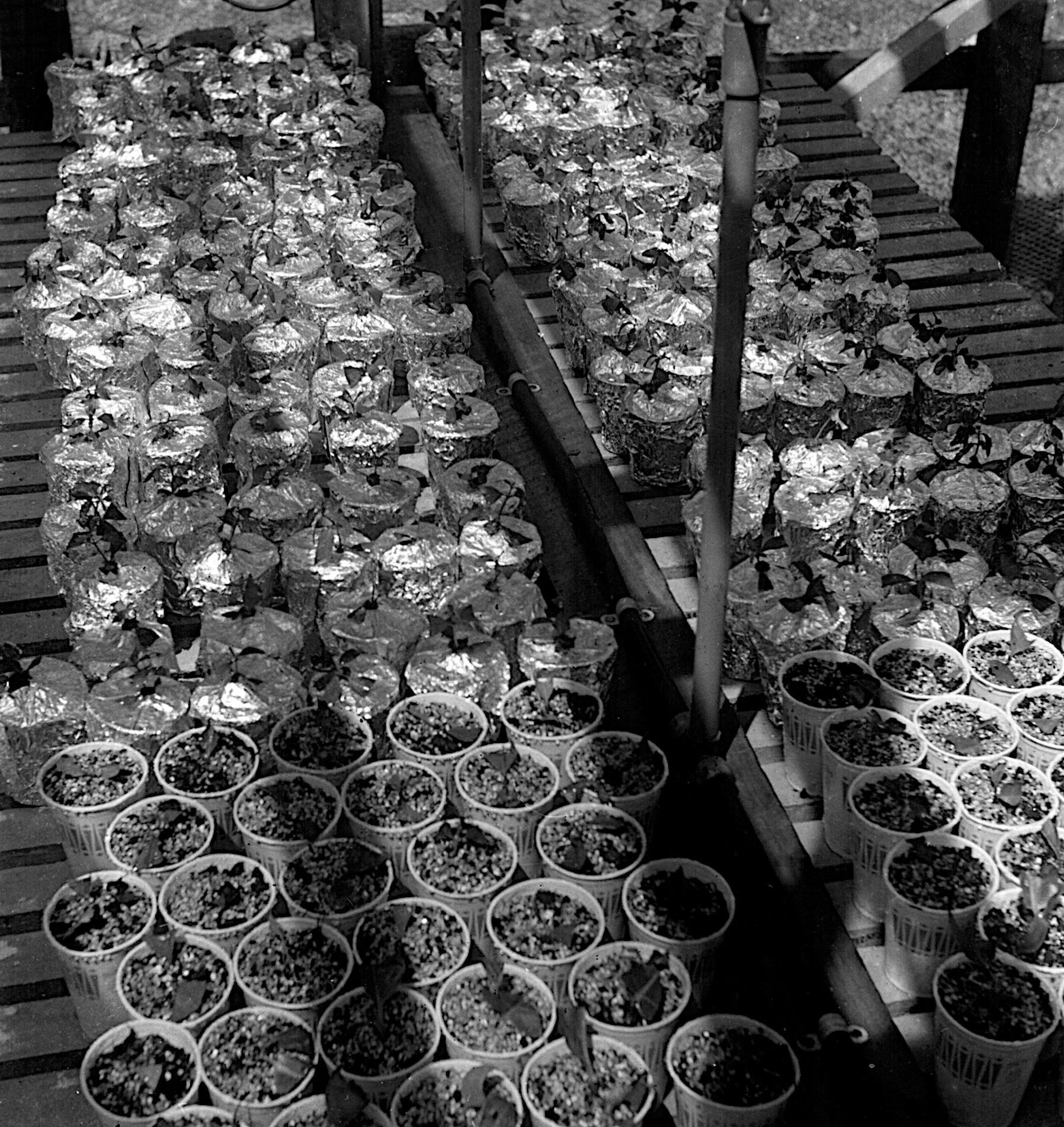
able to be successfully propagated from segmental stem cuttings derived from up to two year old material (at that time, the age limit was extended later).
The following media were found suitable for rooting cuttings of E. deglupta:
1:1:1 shredded peat, vermiculite, coarse sand
2:1 vermiculite, shredded peat
1:1 coarse sand, vermiculite
1:1 vermiculite, perlite.
In the absence of the above components, coarse (sand like) pumice material from deep in an undisturbed profile at Keravat could be used without sterilization.
Left: Cuttings of a mix of E. deglupta clones, three weeks after being transferred from the mist chamber to an outdoor nursery bed. Medium here was shredded peat and vermiculite.
Cuttings were “hardened off” by progressively reducing the frequency of misting. Then they could be transferred while still in their original containers to an open nursery bed and cared for in the same way as tubed stock.

For cuttings to be used for routine plantation establishment there was a need to scale up the procedures so far proven on a small scale to mass produce thousands of cuttings. The immediate constraint posed by the location of activities in Keravat was the availability of suitable containers, hormones and misting equipment. Steamships plantation and horticultural supplies divisions in Rabaul were contacted to determine what was immediately available in the Territory.
The next step was to ensure rooting success could be kept high by continual rejuvenation of the source material used for cuttings. This was achieved for seedlings by keeping them in large pots where the continual harvesting of nodal cuttings produced a hedged plant maintained in the juvenile condition (next page).
Right: Two seedlings of E. deglupta of the same calendar age in 30 cm diameter bags at Keravat in 1967. The one on the left was been allowed to grow normally to a height of about one metre, the one on the right had been held in a more juvenile condition by the hedging effect of sequential harvests of nodal cuttings. The contrast between the “normal” more mature leaf shapes on the plant on the left with the juvenile leaf shapes of all of the leaves of the hedged plant on the right was quite stark.
Peat pot strips usually used for vegetable growing were made available in quantity. Each strip comprised 24 tapered pots about 40 mm square at the top and 50 mm deep. While for the tree cuttings 100 mm or more in depth would be desirable, 400 strips of the available stock of 50 mm deep pots were purchased. Also available for immediate purchase was “Seradix” rooting hormone powder for improving the strike of woody cuttings (active ingredient 3 indolebutyric acid). “Aquasol”, a water soluble complete fertilizer, was also available and purchased. Adjustable mist nozzles were available. A compact electric pressure pump normally used in household situations to pressurize domestic water delivery systems was purchased along with an electric timer, hoses, pipes and fittings. At Keravat, a nursery bed with a concrete base was set up for the mass propagation of E. deglupta cuttings.
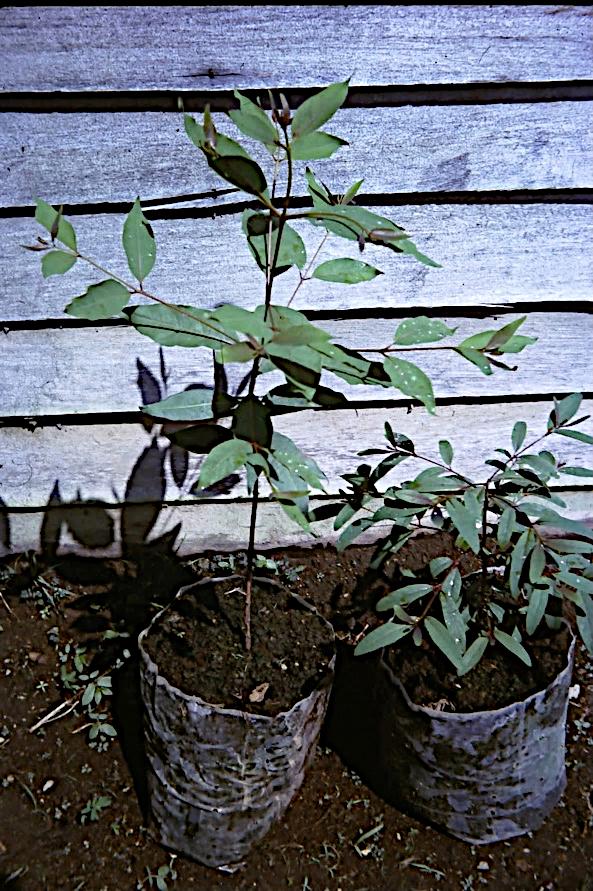
Mass production of E deglupta cuttings at Keravat in October 1967. 1 Hose connection from existing water supply, 2 Electric pressure pump and timer, 3 Crude corrugated iron cover (to give some protection of the pump, electrics and hoses from the sun and rain), 4 One inch (2.5 cm) galvanized pipe carrying pressurized water to downward facing mist nozzles at one metre intervals, supported on legs of similar pipe (welded on in the Forestry workshop), 5 Hessian cover, 6 Cuttings in strips of 24 peat pots held upright in plastic trays. The mist tent could be moved along the concrete bed in stages to produce rooted cuttings in batches of about 2,000. Cuttings were harvested from the young trees growing in the bed in the background.
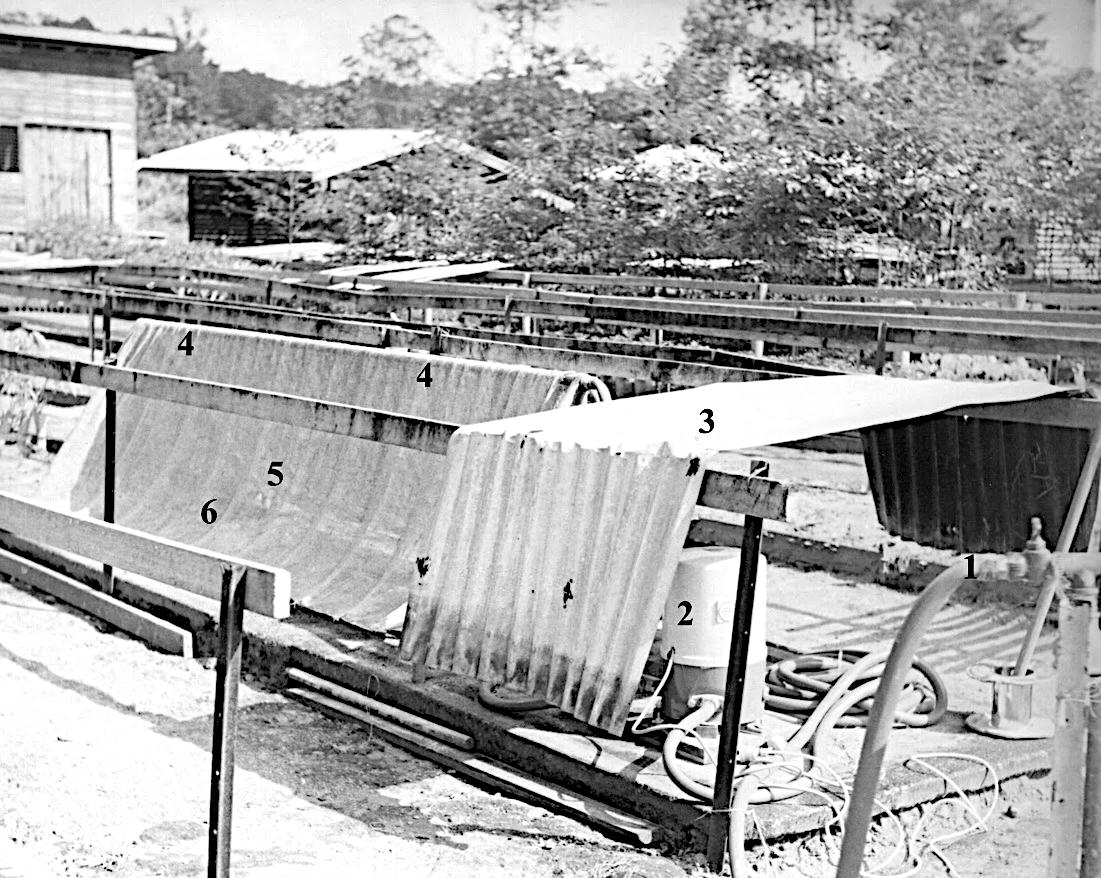
Above: a. A segmental cutting of E. deglupta is represented. Because the leaves are usually opposite in this species a single node comprised a pair of leaves. The leaf area was reduced by at least half. The cutting was dipped in hormone powder and inserted in a free draining medium in a peat pot. b. After about 3 4 weeks roots develop first, followed by a shoot from one or both of the naked axillary buds. Right: A cutting at the same stage as shown in diagram b above, washed free of shredded peat and sand growing medium to show the root system and a shoot emerging from one of the naked axillary buds. (Scale in cm, near actual size)
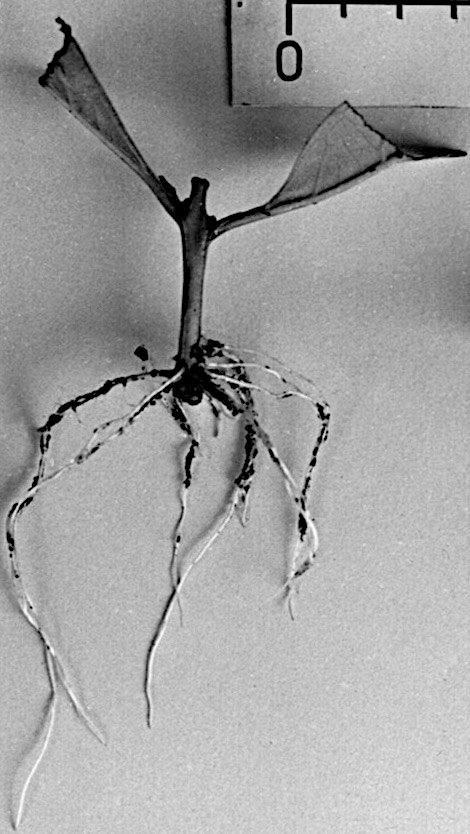
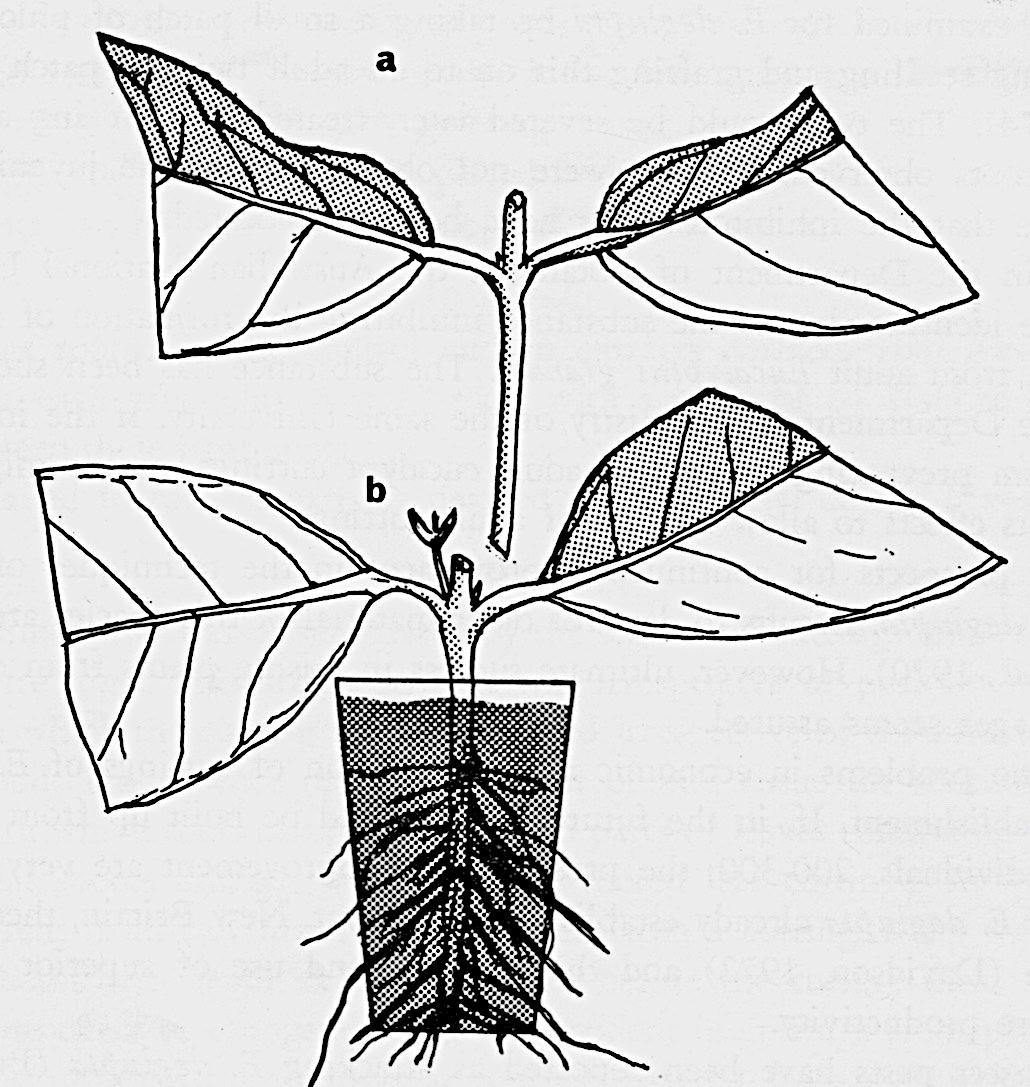
Four thousand cuttings were raised by cloning 30 young E. deglupta grown in a separate nursery bed close to the propagation bed (ortets). These young trees were not preselected in any way. The number of cuttings (ramets) from each ortet numbered from 5 to 60 depending on the availability of suitable nodes for harvesting from the ortets. Differential rootability and survival of the cuttings under mist and during hardening off caused further variation in the number of ramets of each clone ready for planting in the field.
The cuttings in their peat pots were transported to Vudal Compartment 2 and planted in early December 1967. The chosen area of the Compartment for the trial was flat and next to the Vudal River. The area was part of the routine planting area for the year and had been burned and bunked one month previously. Cuttings were planted while still in their peat pots in rows at 8 x 8 foot (about 2.5 x 2.5 m) spacing, with related cuttings kept together in one or more rows for the clones with a large number of representatives.
The less represented clones were planted together but with several clones spaced successively along a row.
The chronological age of each in
of the cutting was the same. The noticeable difference in
of
and apical
between the two may have been because the grafted tree had arisen from bud tissue of greater physiological age than the tissue that gave rise to the cutting. The former had come from a large tree, while the cutting had come from a young seedling. Another difference was that the grafts tended to flower much earlier than the cuttings and a slight change in crown architecture preceded flowering.
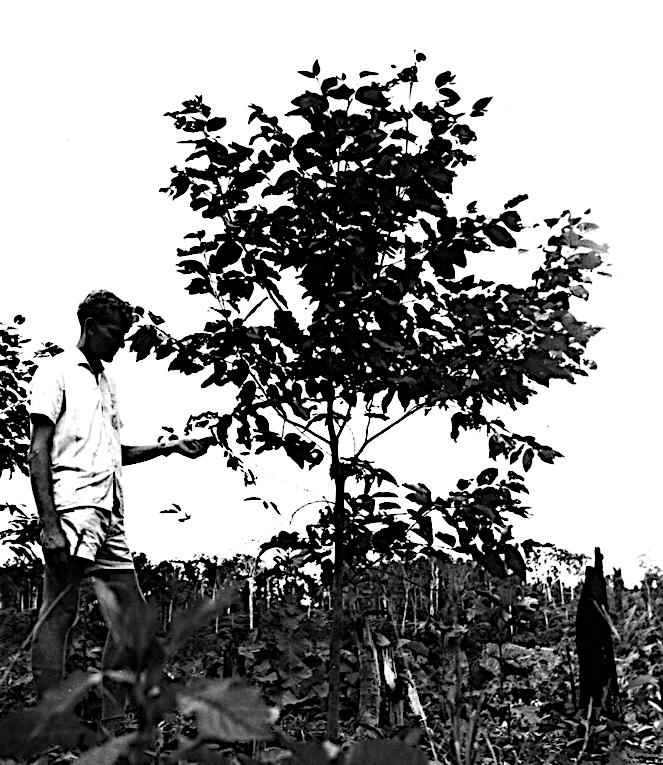
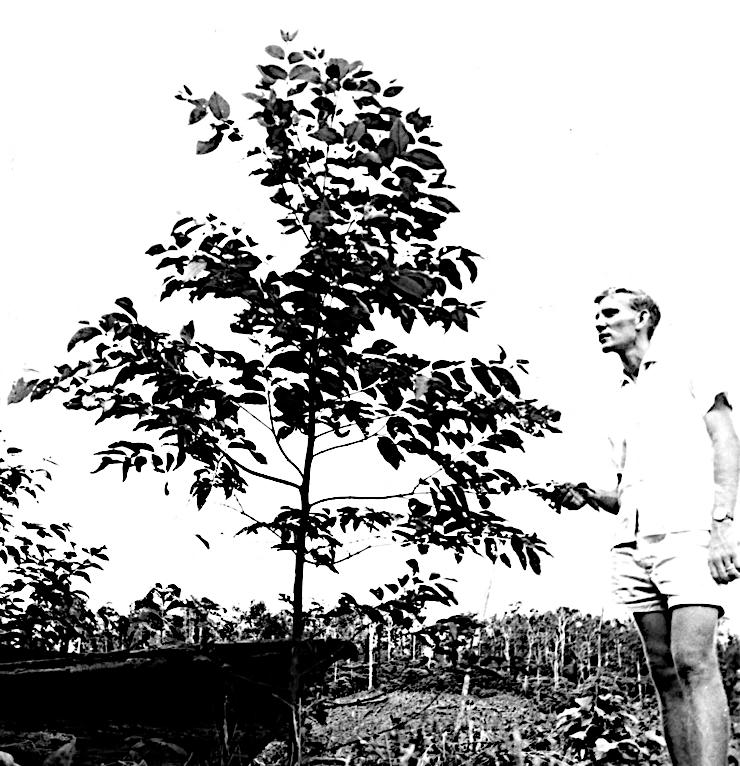
As a result of favourable results from pulping studies of mixed species hardwoods from lowlands rainforests by the Wood Products Laboratory of the Commonwealth Scientific and Industrial Research Organisation (CSIRO) in Melbourne48 and the recommendation arising from an IBRD Mission49 to increase production from the Territory’s forests, a number of the major Timber Rights Purchase (TRP) areas were identified for logging with a major component devoted to harvesting lowland rainforest for
48 Results were received within a year, but remained “Commercial in Confidence” within the Department of Forests for more than a decade, until the CSIRO was given permission for their publication in abridged form. Publication occurred in Phillips F H, Logan A F and Balodis V 1979 Suitability of Tropical Forests for Pulpwood: Mixed Hardwoods, Residues, and Reforestation Species. Tappi 62(3):77 81.
49 In 1966, the Territory Government, through the Minister for Territories, had asked the International Bank for Reconstruction and Development (IBRD) to consider a programme of lending for the Territory. A Mission visited the Territory in March 1967 with the task of ‘updating the Bank’s information on the economy and identifying possible projects for Bank (or International Development Agency (IDA)) financing’. The IBRD officials were R.J. Goodman (Chief of Mission), G.H. Reif and E. Lamers (Economists). Their Report was submitted in August 1967: ‘Current economic position and prospects of the Territory of Papua and New Guinea’, vol. 1, 9 August 1967, NAA: A1838, 846/2 part 3).
chipping in country, and export of those chips overseas for pulp production. Of the 13 areas, nine were in localities that had, or were close to, natural stands of E. deglupta. This supported the Department’s earlier decision to concentrate research on E. deglupta as the best choice for reforestation in those nine areas after the original forest had been clearfelled for chips. Notable exceptions were the North Coast, Gum, Naru and Gogol TRP areas near Madang that were a long way from any natural riverine forests of E. deglupta. Seemingly at odds with the decision to concentrate lowlands reforestation research on E. deglupta was the continued early promotion of the Gogol and the nearby TRPs for tender, locations where this species might turn out to be a less than optimum choice. (There was in fact no natural occurrence of E. deglupta along most of the rivers flowing out of the east and north coasts of the mainland, northwards from about the southern boundary of Morobe Province, and westwards through Madang Province and East Sepik Province to just east of Vanimo in West Sepik (Sandaun) Province.)
Location of major TRPs for where anticipated chipwood logging for export would be a major component. The expectation was that, at least for areas near where E. deglupta was naturally adapted (Vanimo, Kumusi, Girua Kalio, Gadaisu and Sagarai TRPs), and especially on New Britain (Open Bay, Kulu Dagi, Kapuluk and Ania Kapiura TRPs), E. deglupta would be the most likely species adopted for reforestation of coupes clearfelled for pulpwood. Gogol (68,000 ha) was advertised from September 1964, but not taken up until 1971; Vanimo (278,000 ha) was advertised in 1968; Open Bay (183,000 ha) was advertised August 1970 and taken up in 1973, Sagarai Gadaisu 120,000 ha was advertised in January 1971 and a further 85,000 ha in February 1971; Kapiura (83,000 ha) was advertised in June 1973; Kapuluk (181,000 ha) in January 1974. In all, a grand total of close to one million hectares was advertised over the decade 1964 1974 with hardly any early positive response from industries.

In late 1967 the Department of Forestry ANU actively pursued the inaugural Honours students to enrol externally for a higher degree to boost postgraduate student numbers. I expressed interest, but only on the proviso that the subject of study would have its origin in the Territory, preferably on the wood quality of E. deglupta.
In October 1967 I was accepted by the ANU to undertake a Master of Forestry degree externally. This gave immediate access to my appointed supervisor, Dr Peter Rudman, in the Forestry Department and to guidance of other staff, including Dr Bill Heather50 and facilities of the Forestry Department, the Botany Department (Professor Lindsay Pryor), the University Library and University Computing Centre with its IBM 360 50 computer and staff. A preliminary Masters programme on the determination of wood properties in tree improvement project for E. deglupta was mapped out.
The first requirement was to examine the variation in wood properties, especially density and fibre length, in individual trees and to determine sample sizes and sample representativeness required to characterize individual trees and populations. Based on some preliminary work by Dr Rudman and one of Dr Rudman’s PhD students on E. regnans, it was decided to sample six trees from the oldest plantations and three trees of similar size from nearby natural forest at Keravat.
In each felled tree nine transverse disks each about 100 mm thick were removed from nine heights: ground level, breast height, 10, 20, 30, 40, 50, 60 and 70 percent of total tree height. The discs were reduced by cutting slabs off three sides to leave just the one radius from bark to pith and oriented in a northerly direction in reference to the standing tree. For the breast height sample, four radii, one in each cardinal direction, were retained. Samples were bundled in cartons and airfreighted to the ANU, via a quarantine fumigation stop in Sydney, during December 1967.
With the backing of the Department of Forests, the Public Service Commissioner in early December 1967 approved three months of duty travel for me to go to Canberra to carry out the work on these wood samples at the ANU.
50 Dr Bill Heather was a District Forest Officer in Rabaul in the late 1940s and early 1950s. He and Forest Ranger W R Fryar at Keravat started the plantation programme with E. deglupta at Keravat in 1948. This first plantation was 19 years old and still existed behind the Davidsons’ house in 1967.